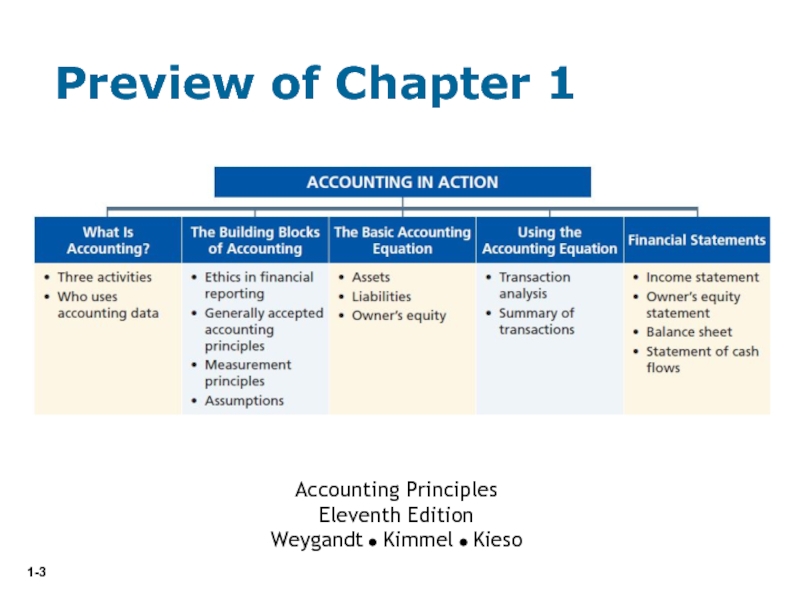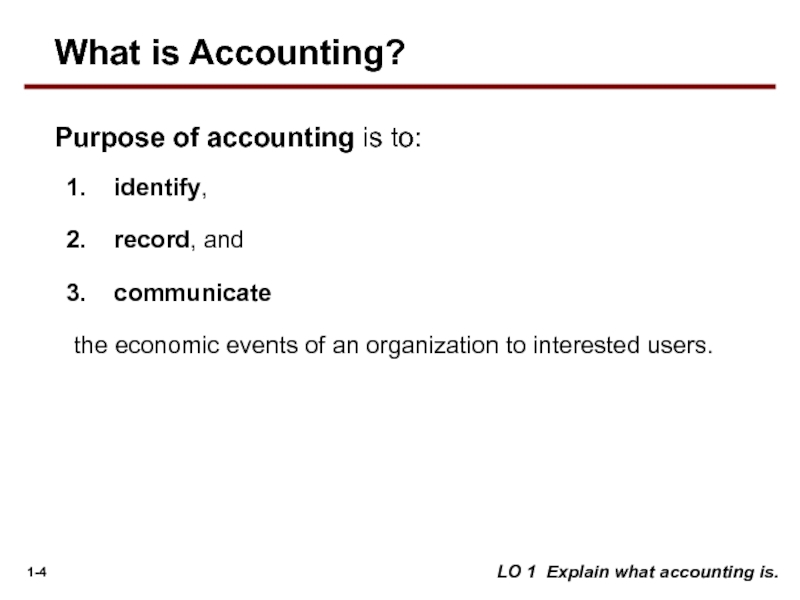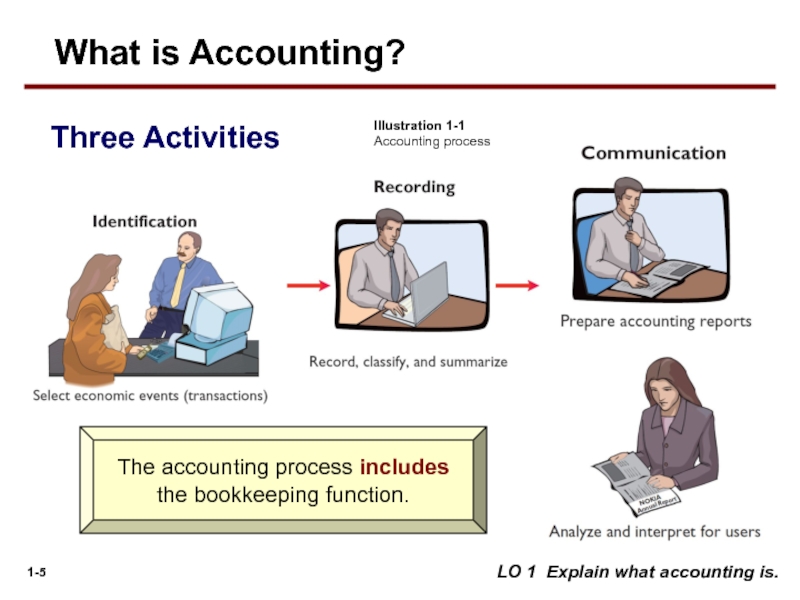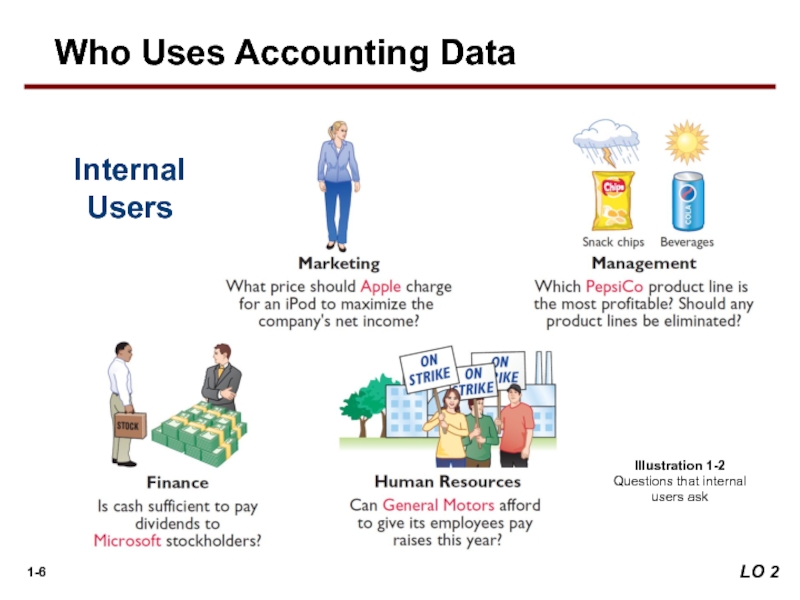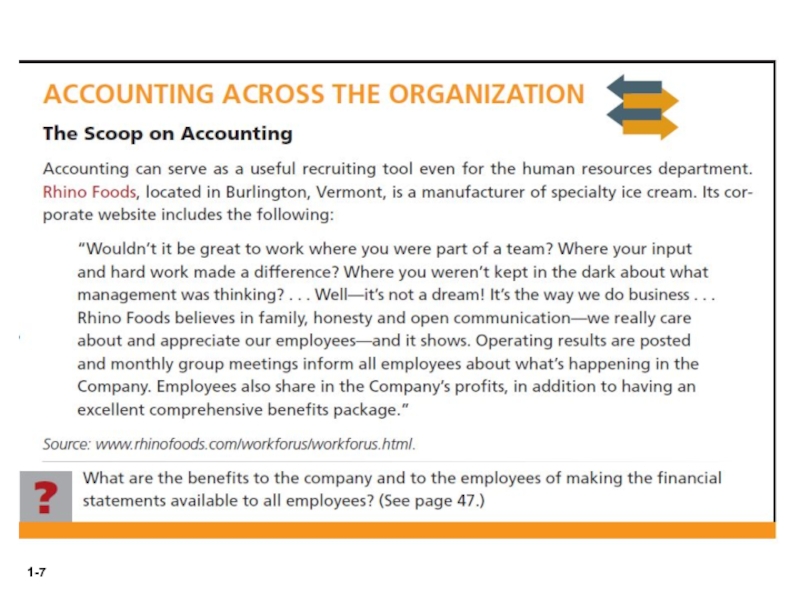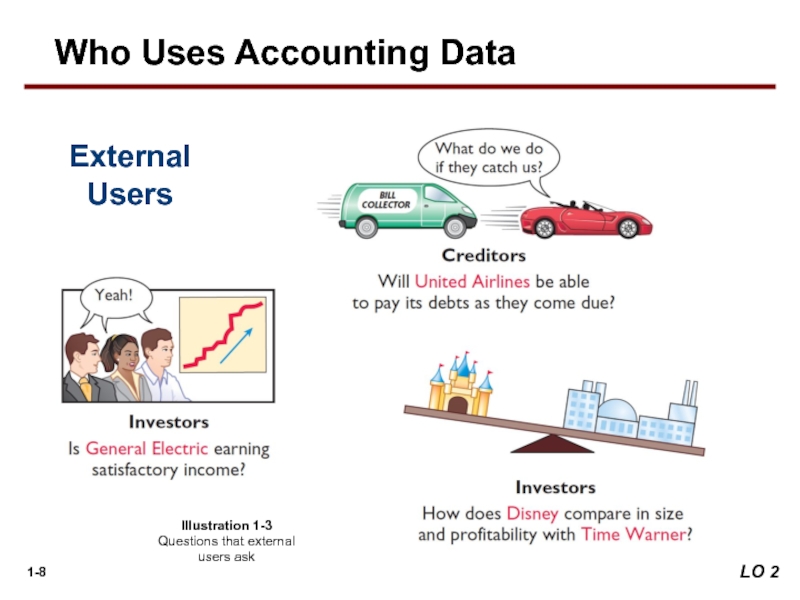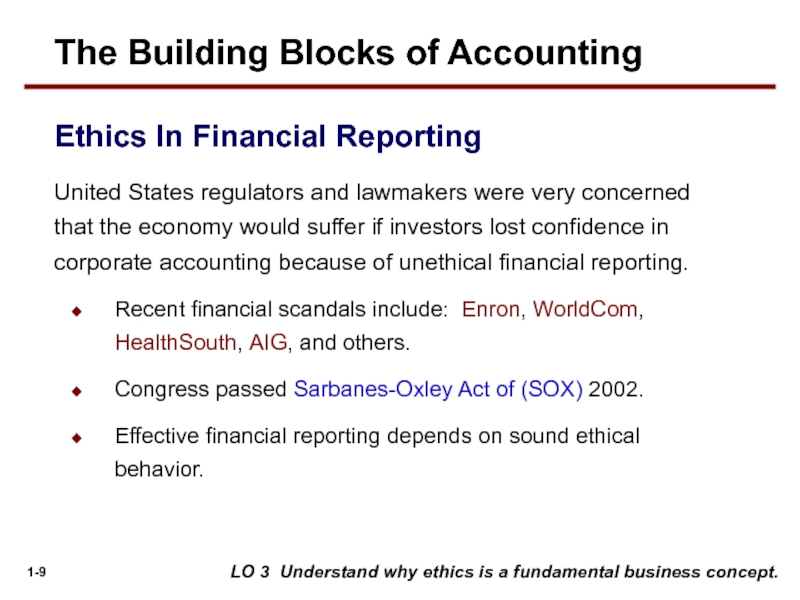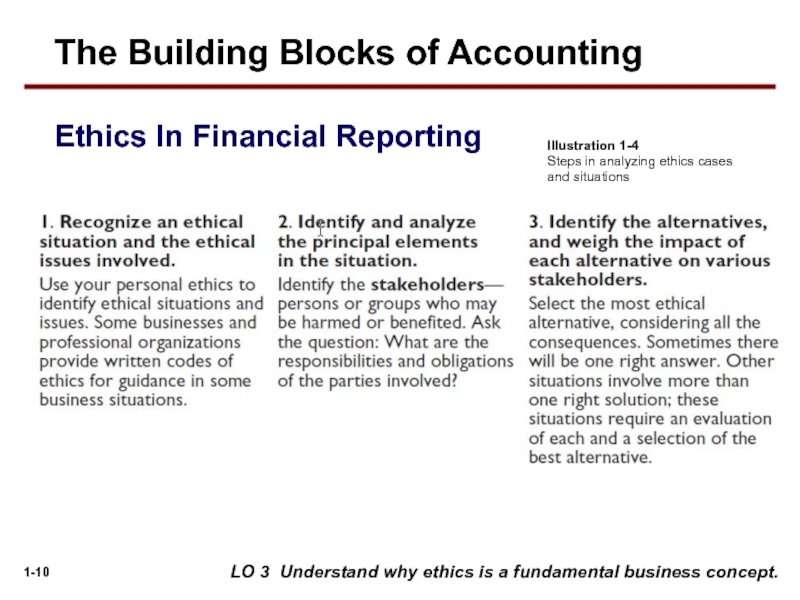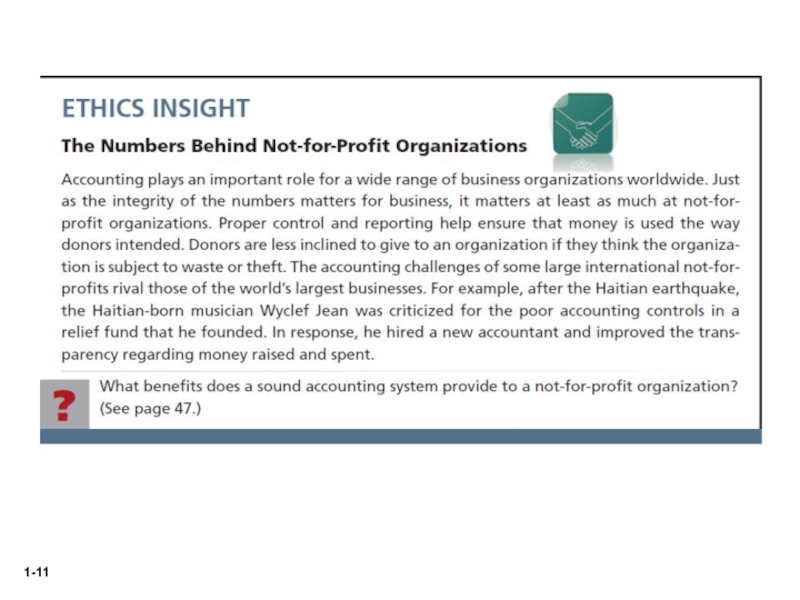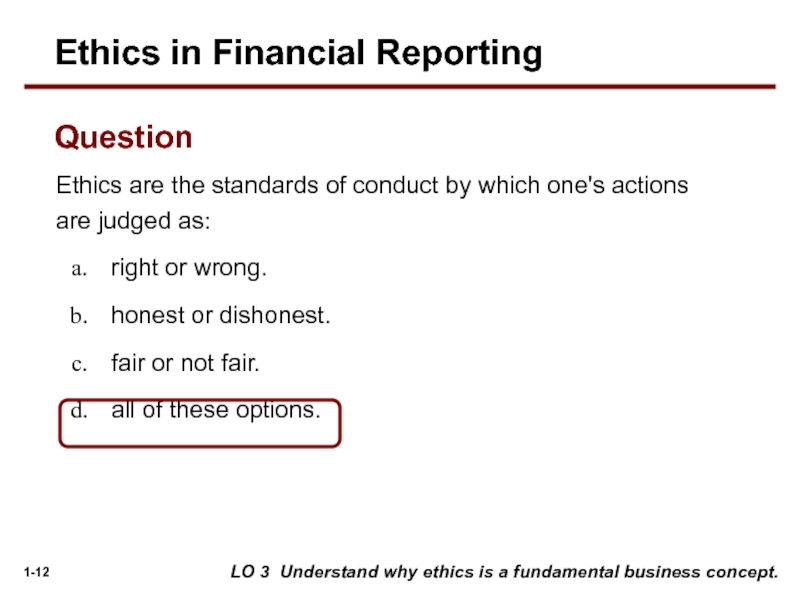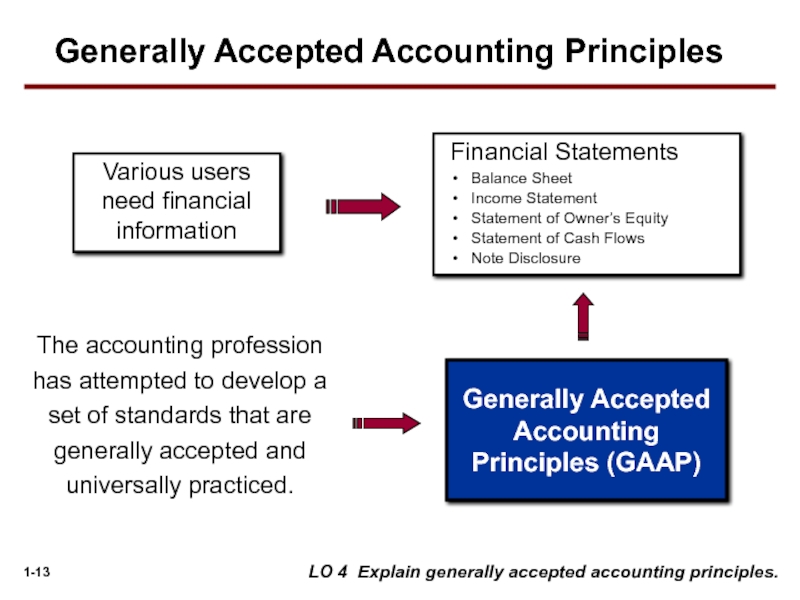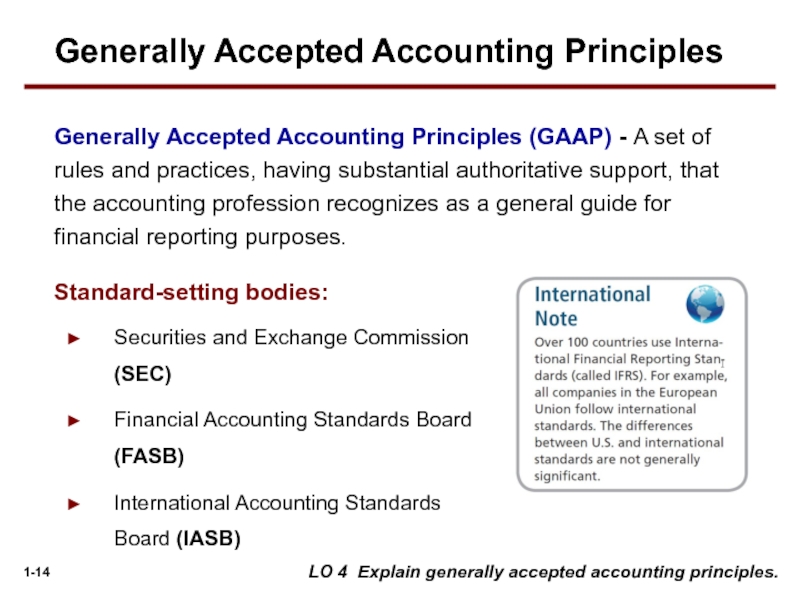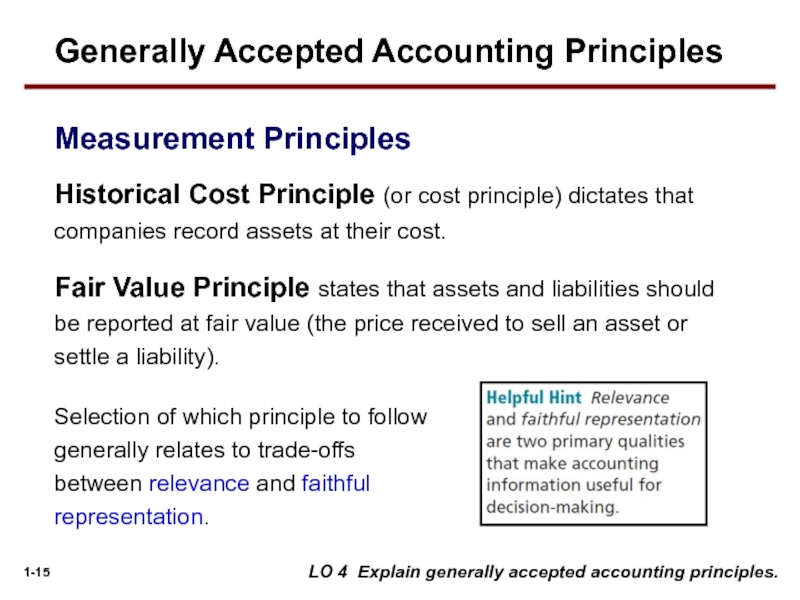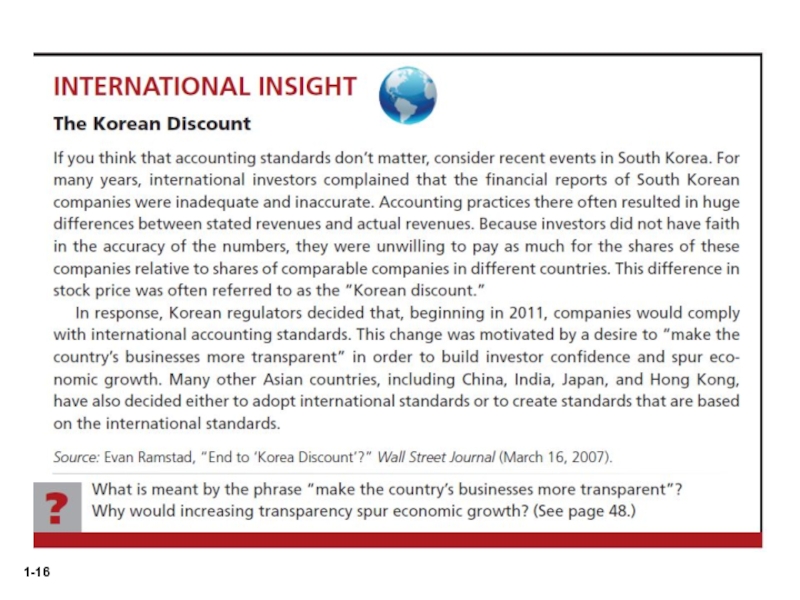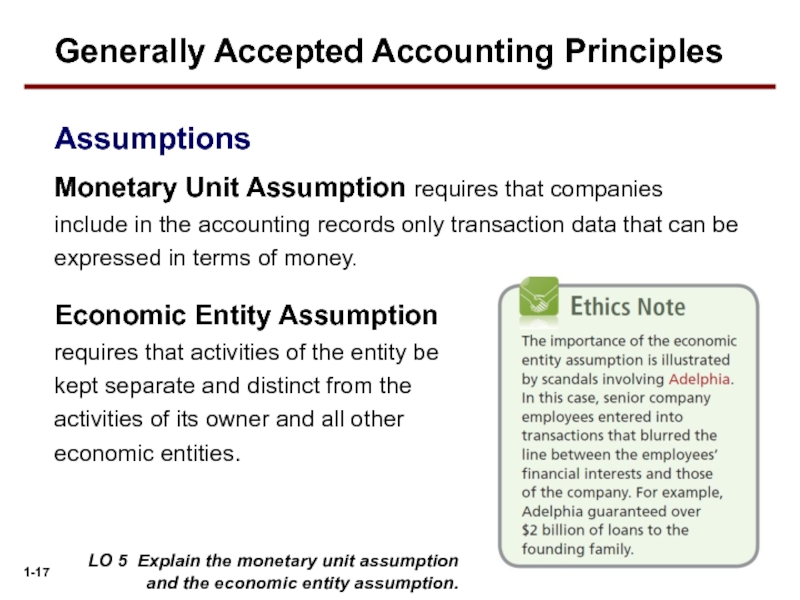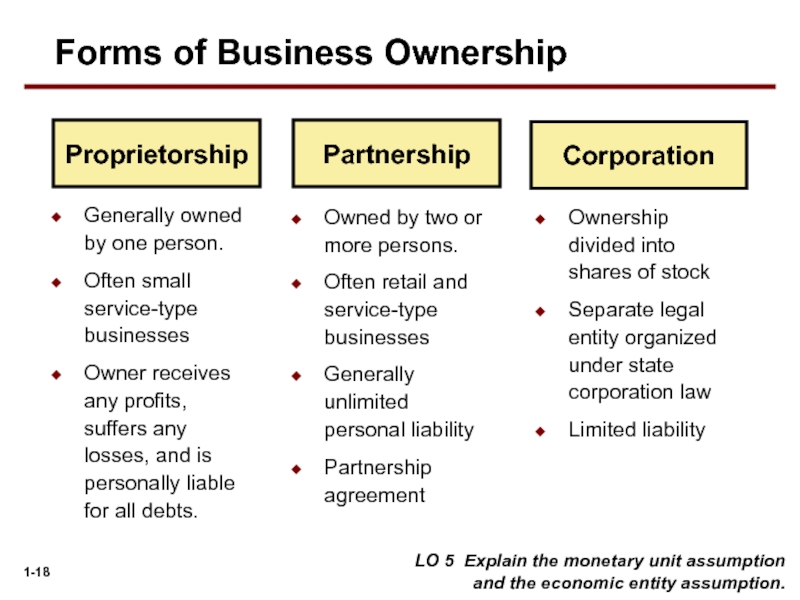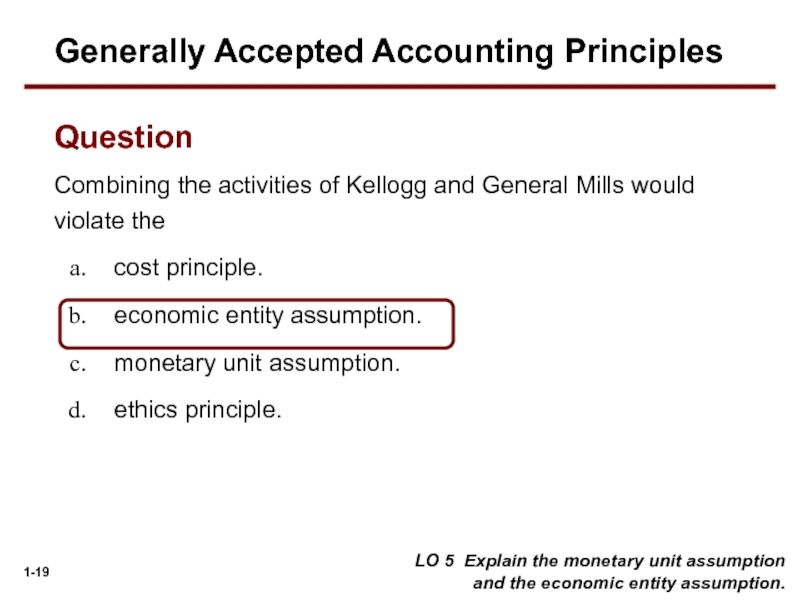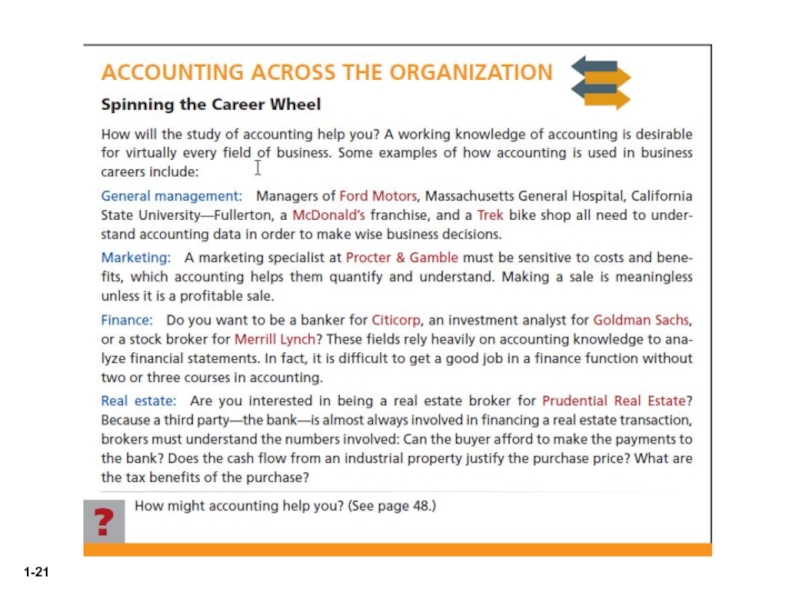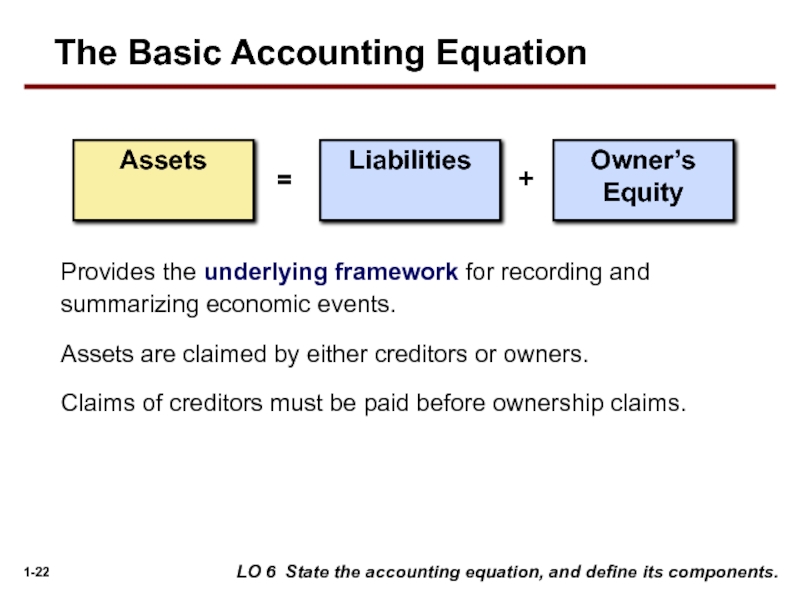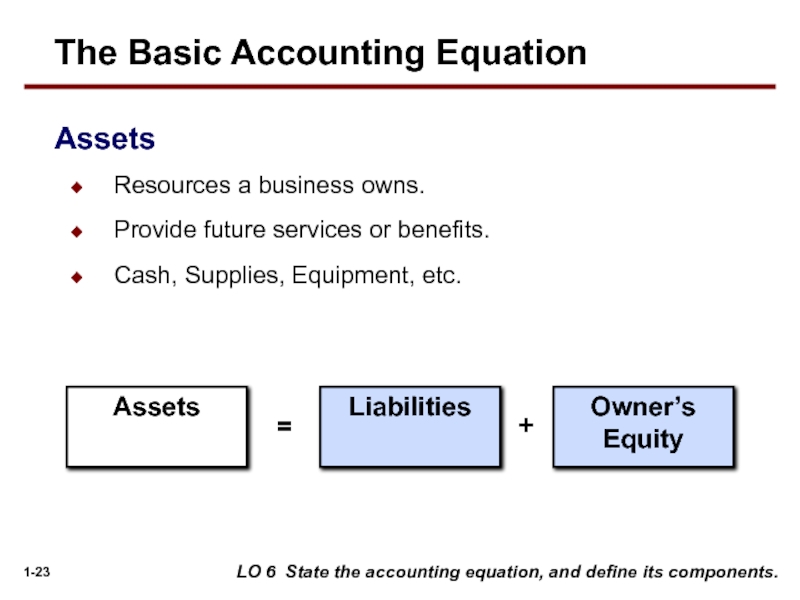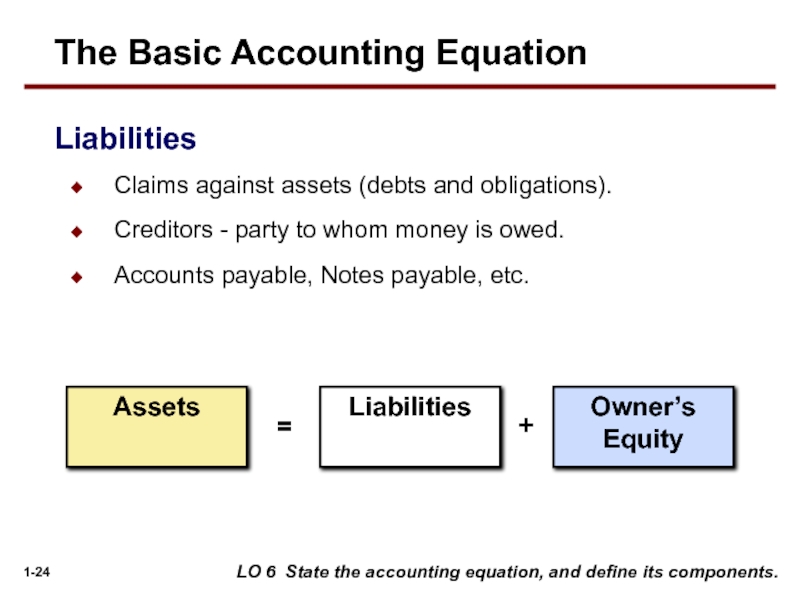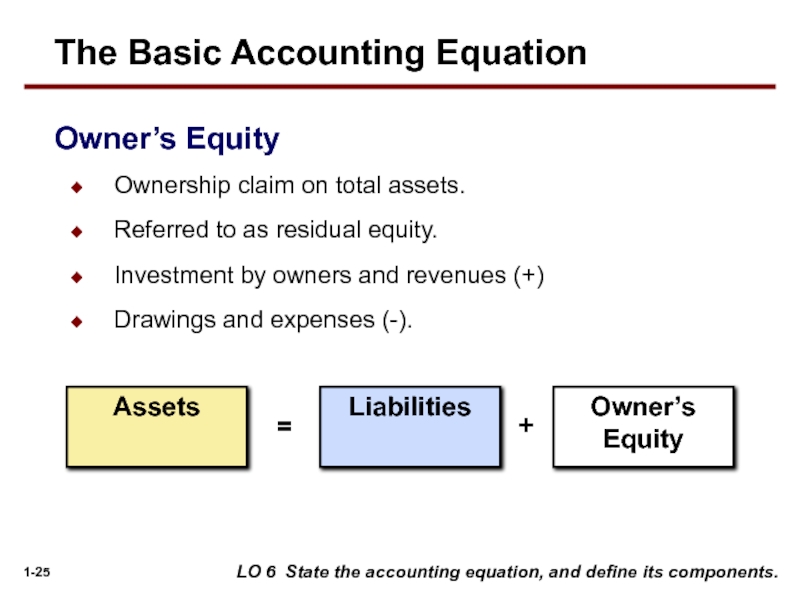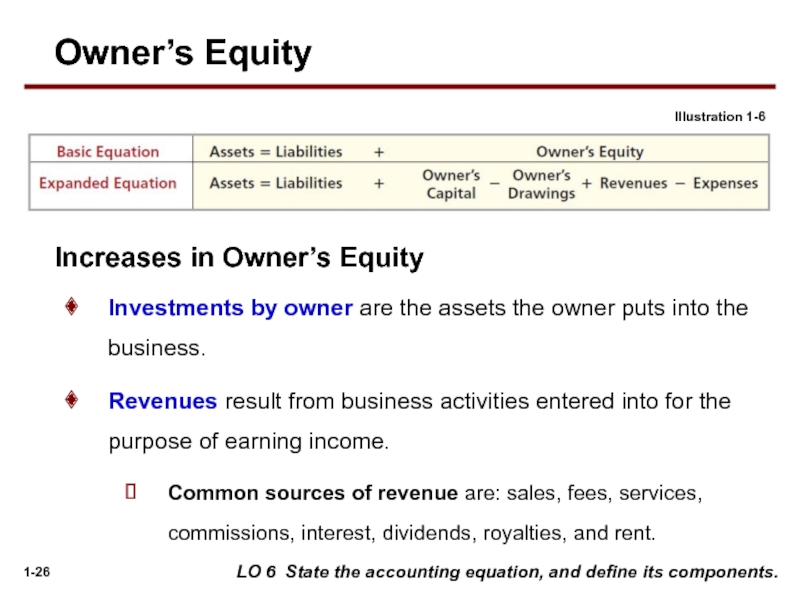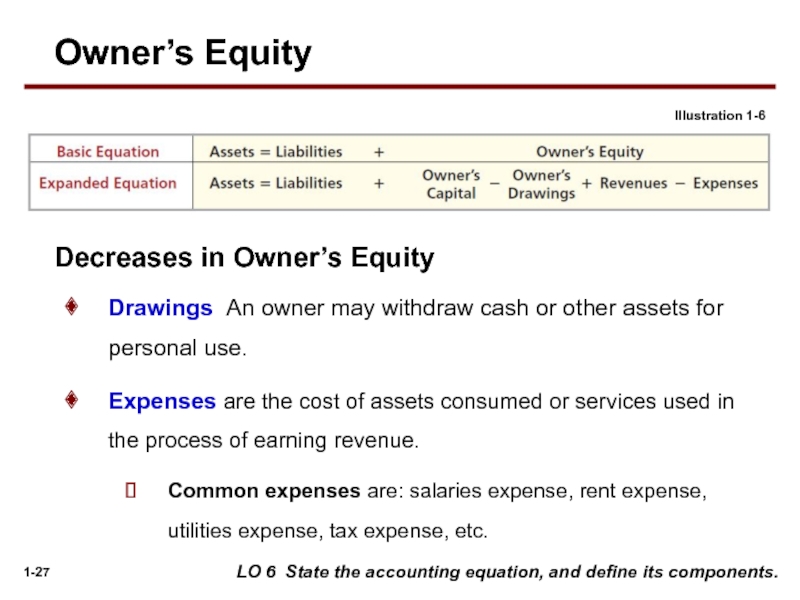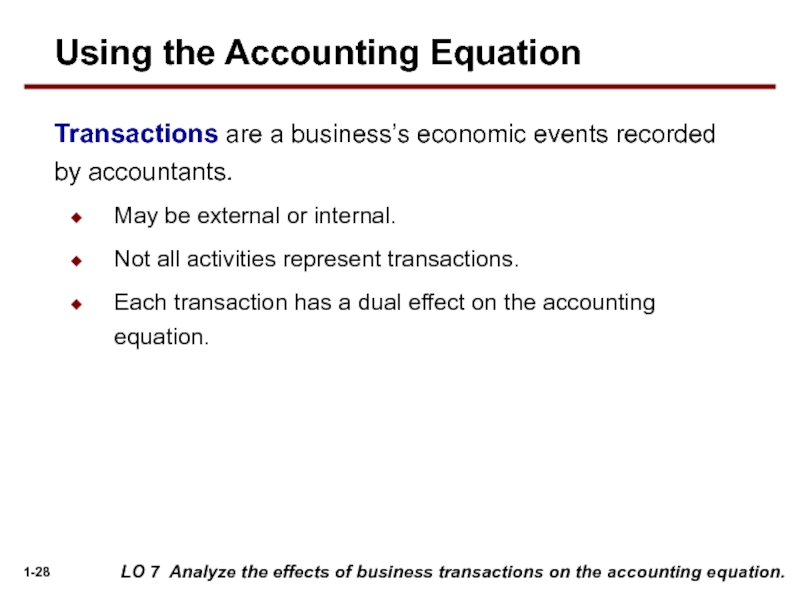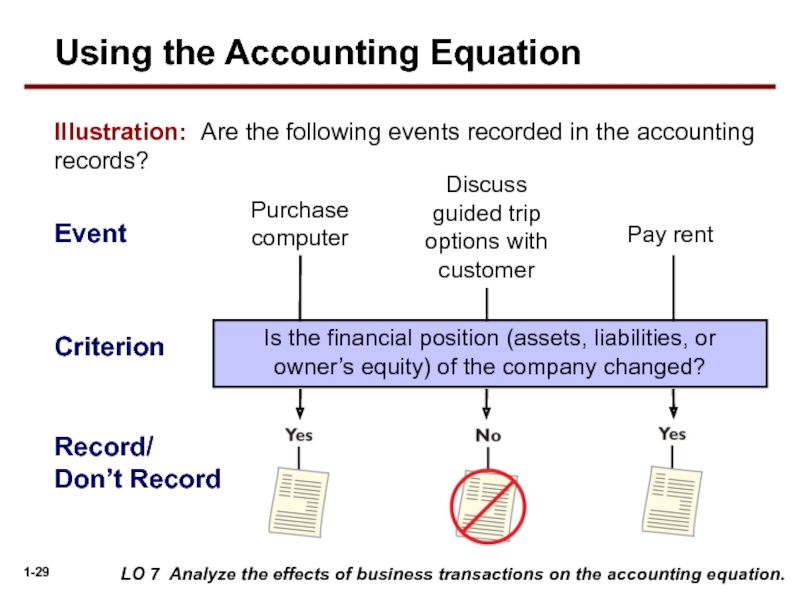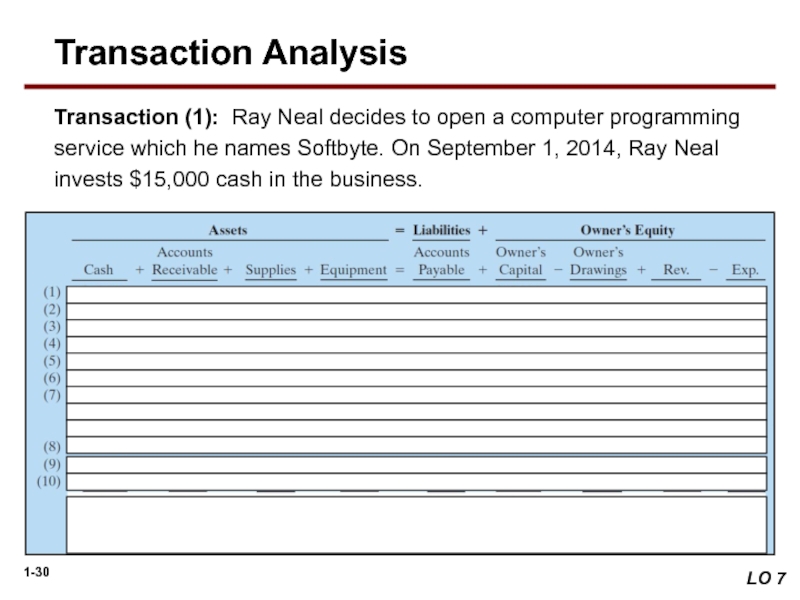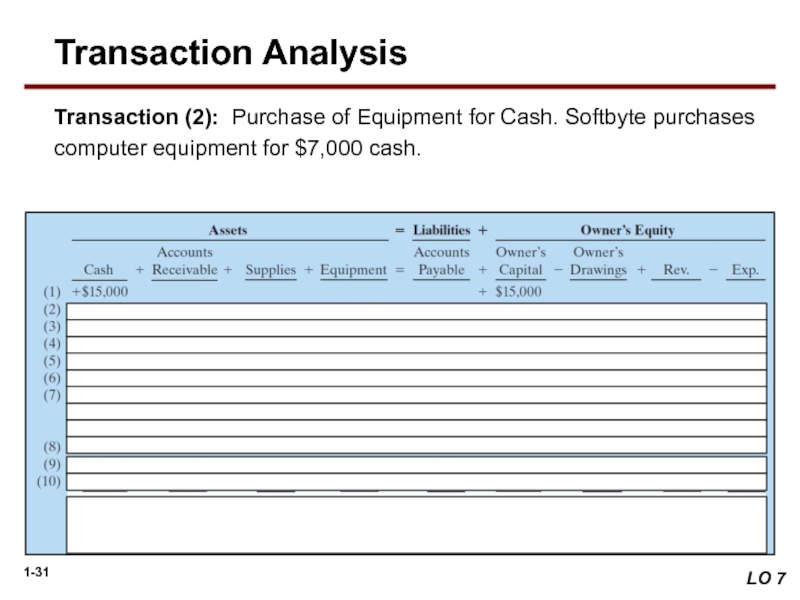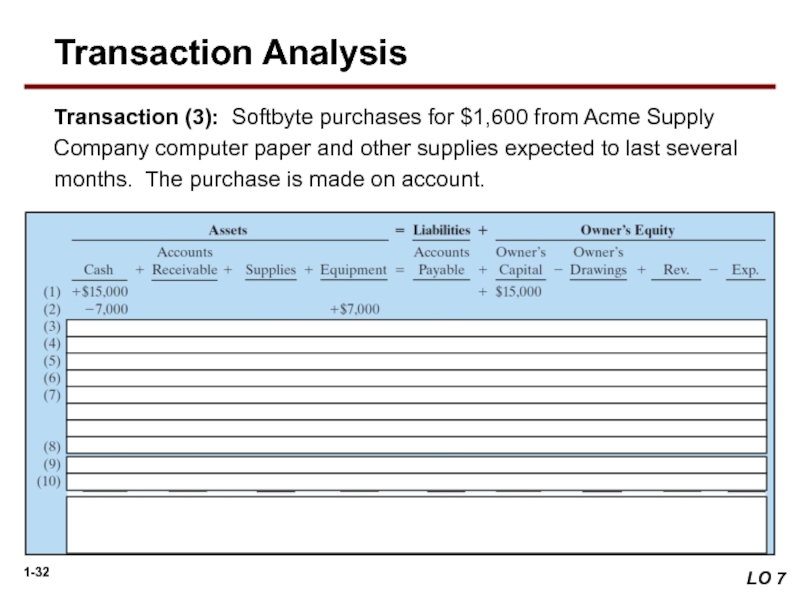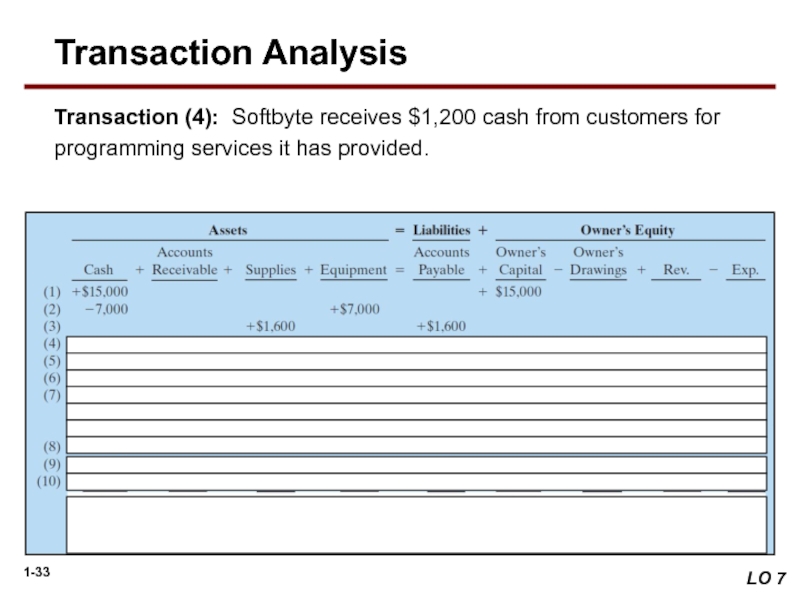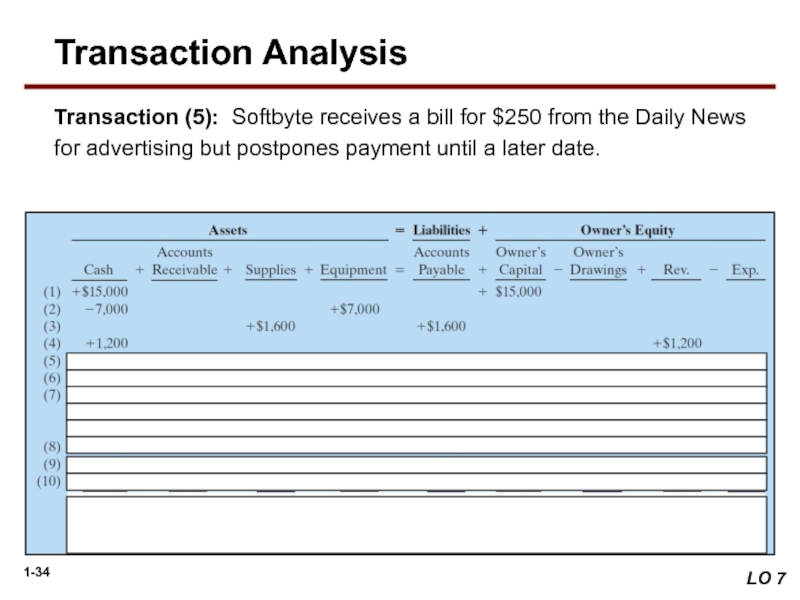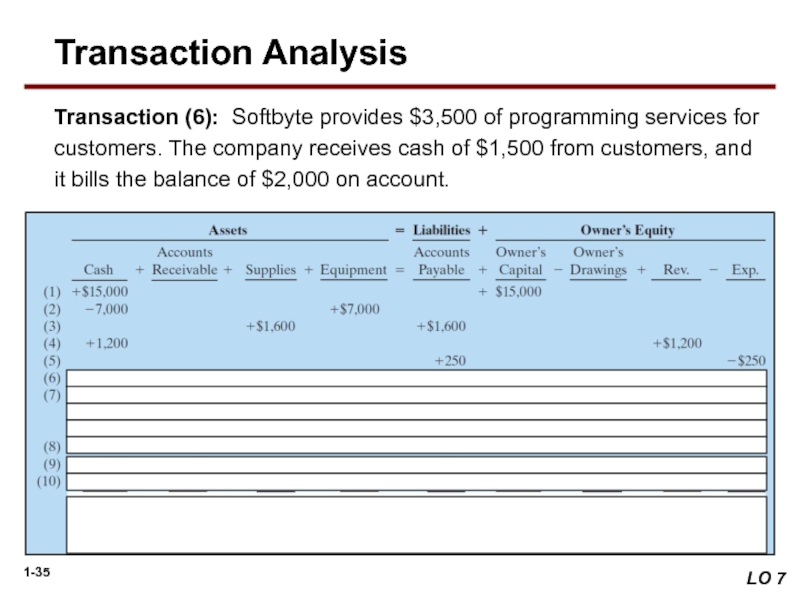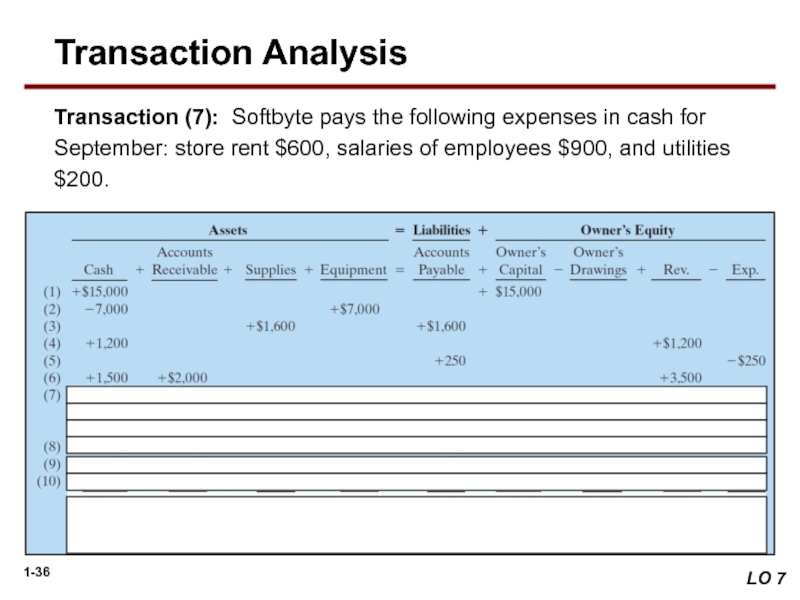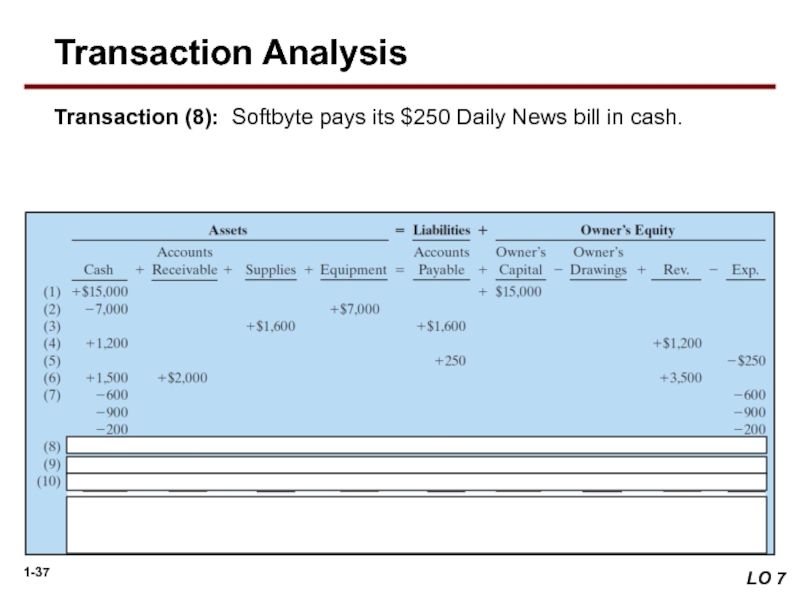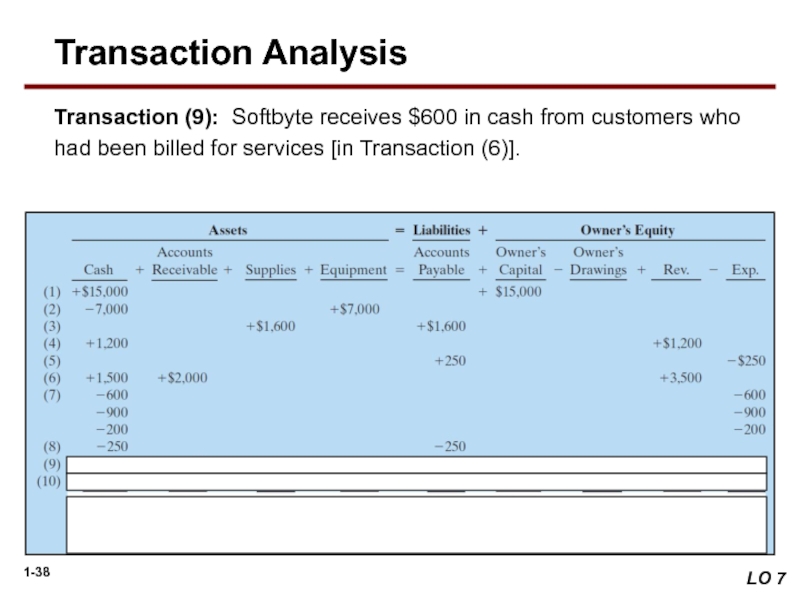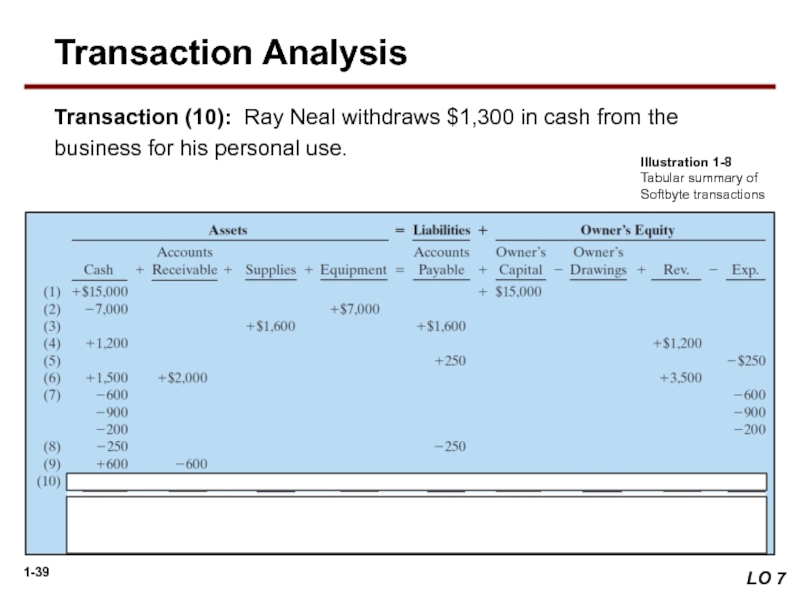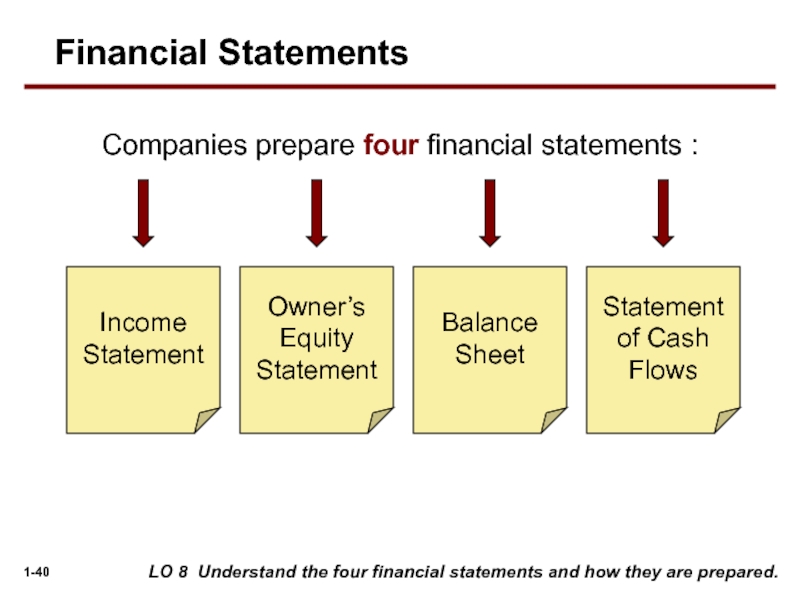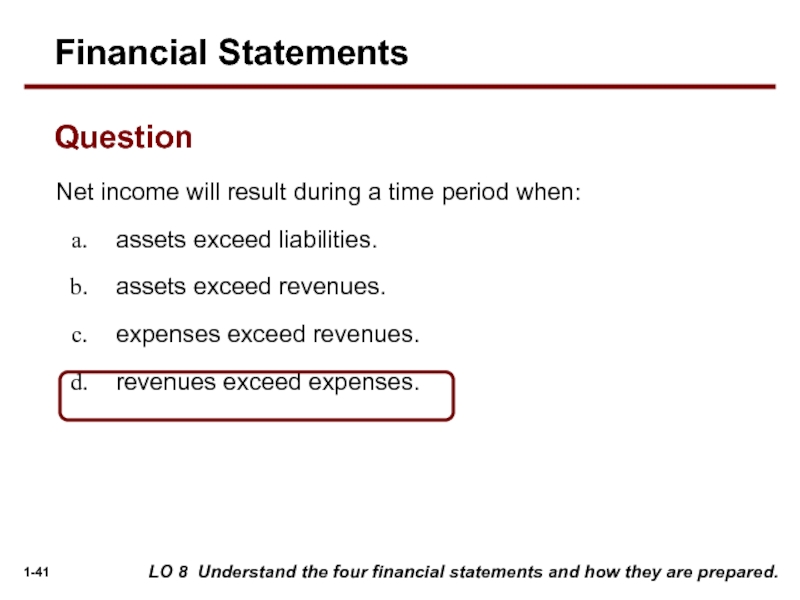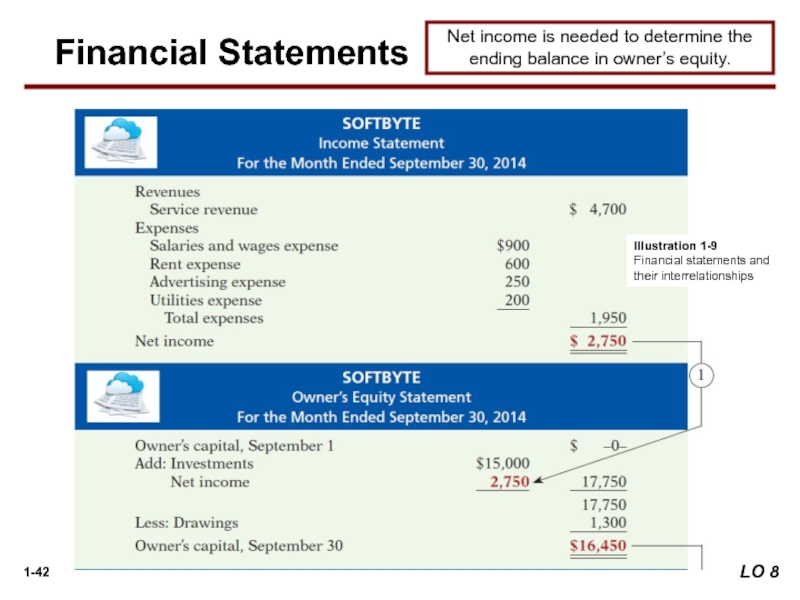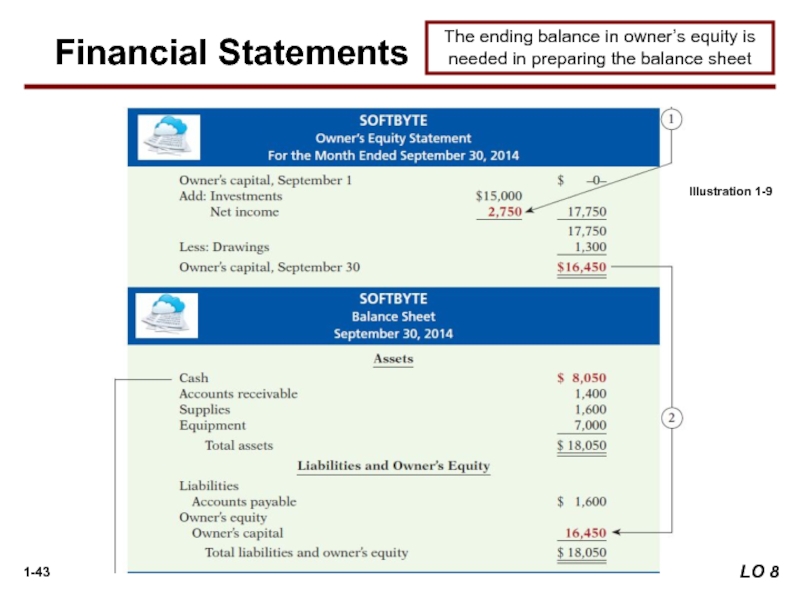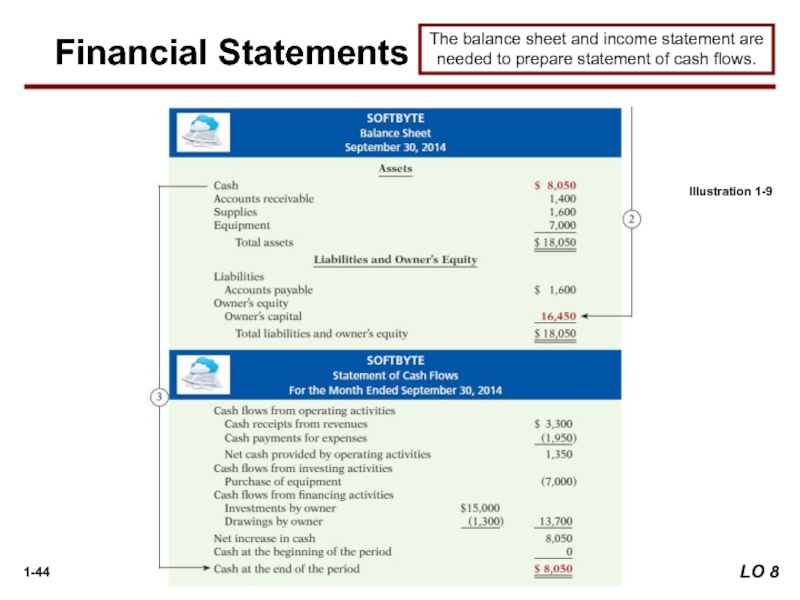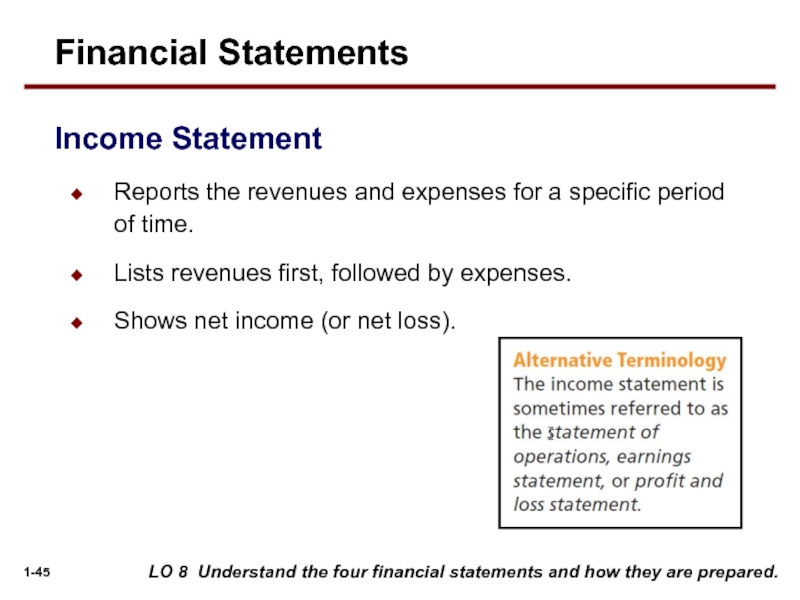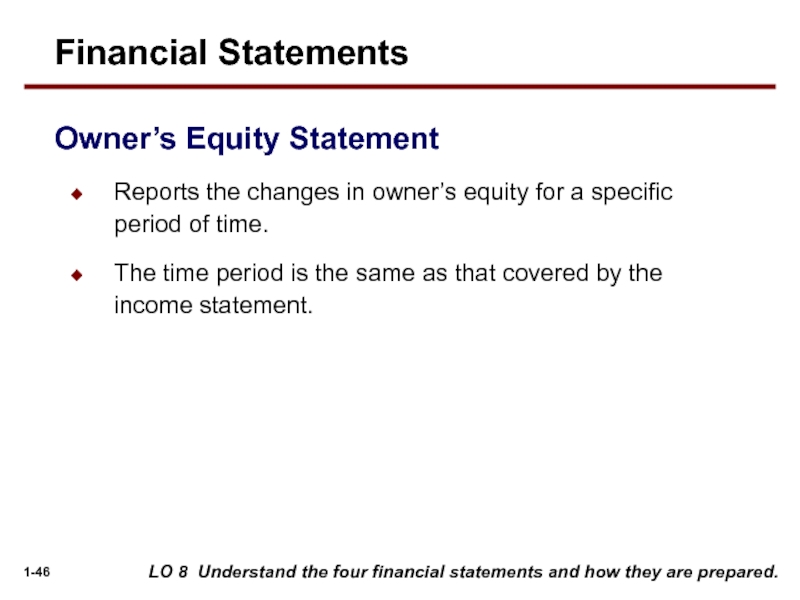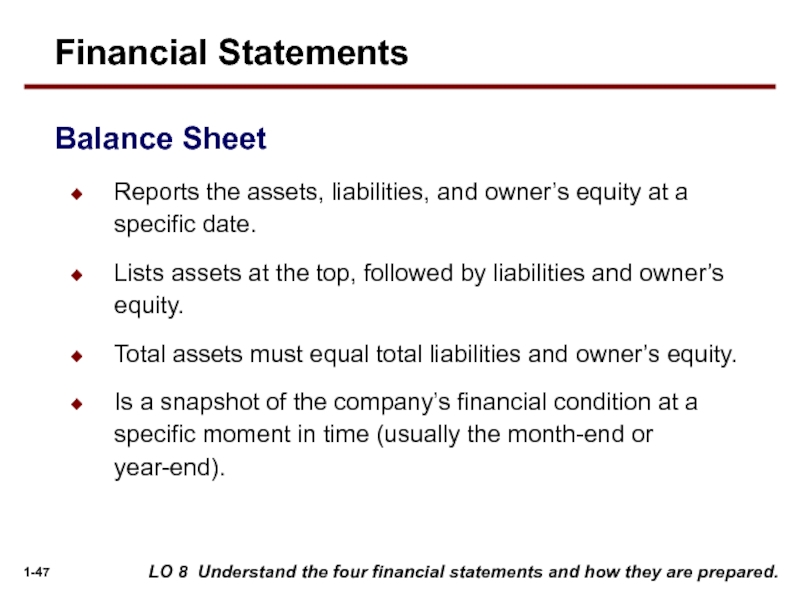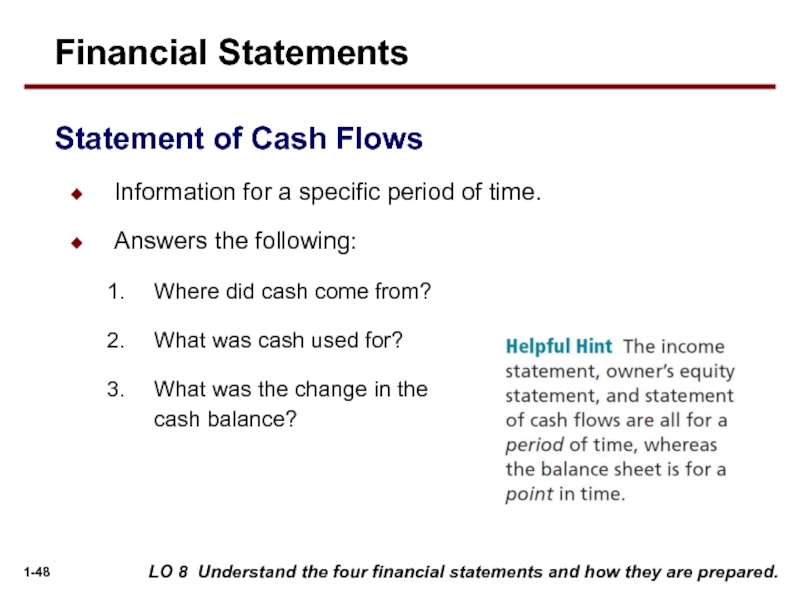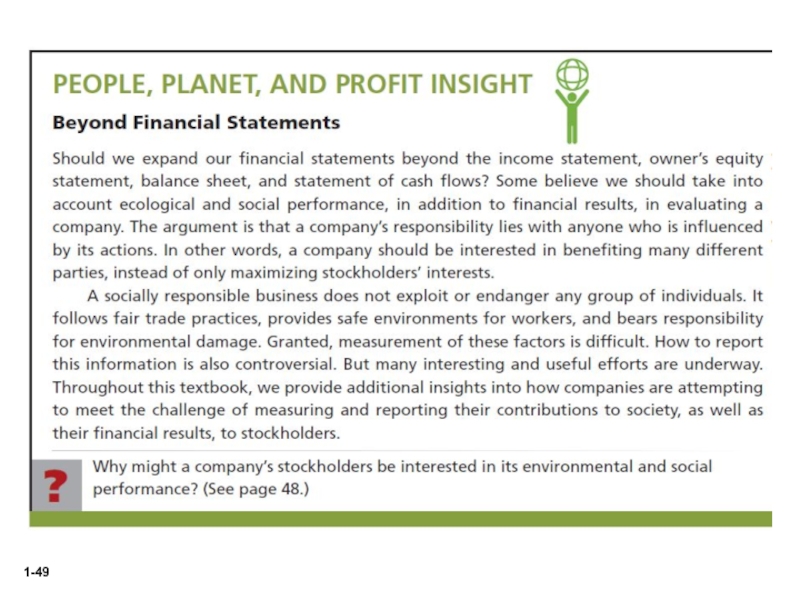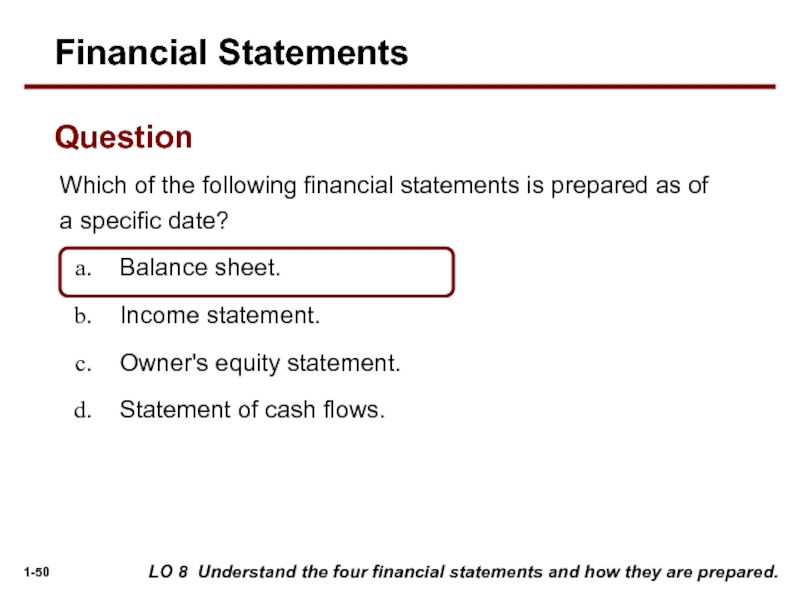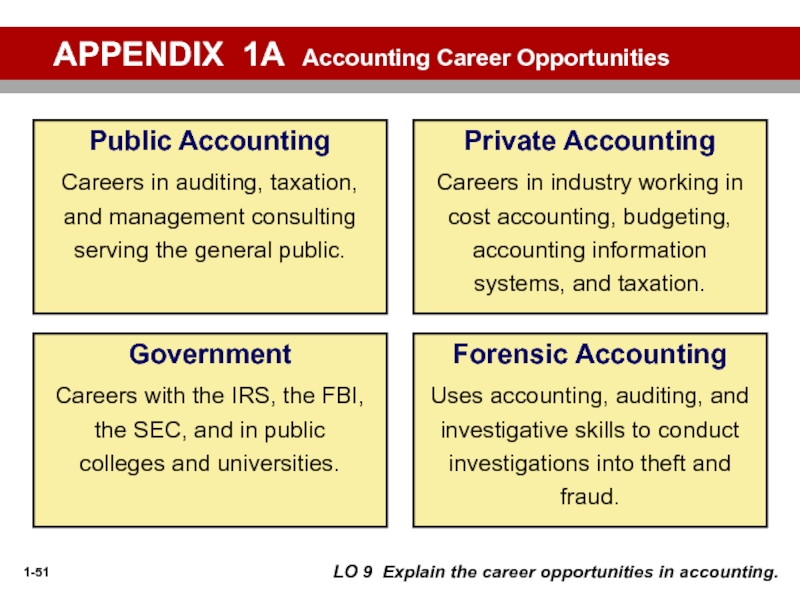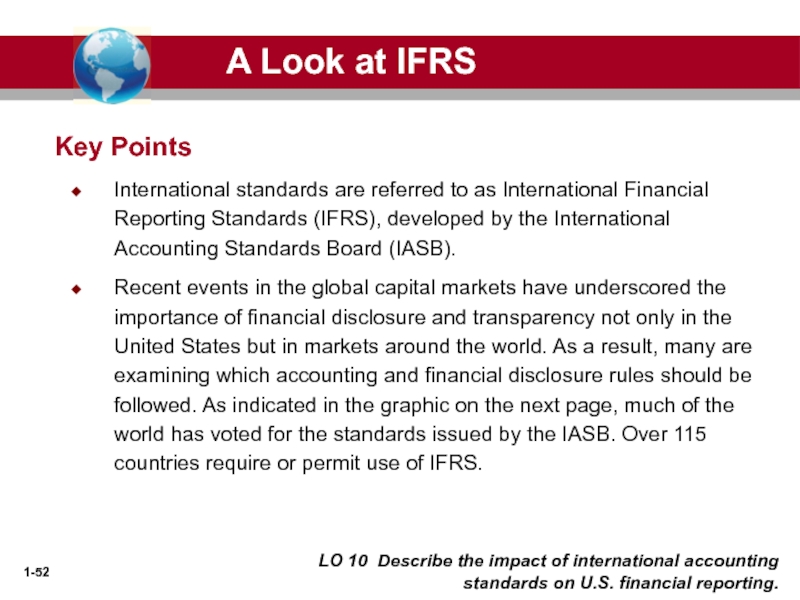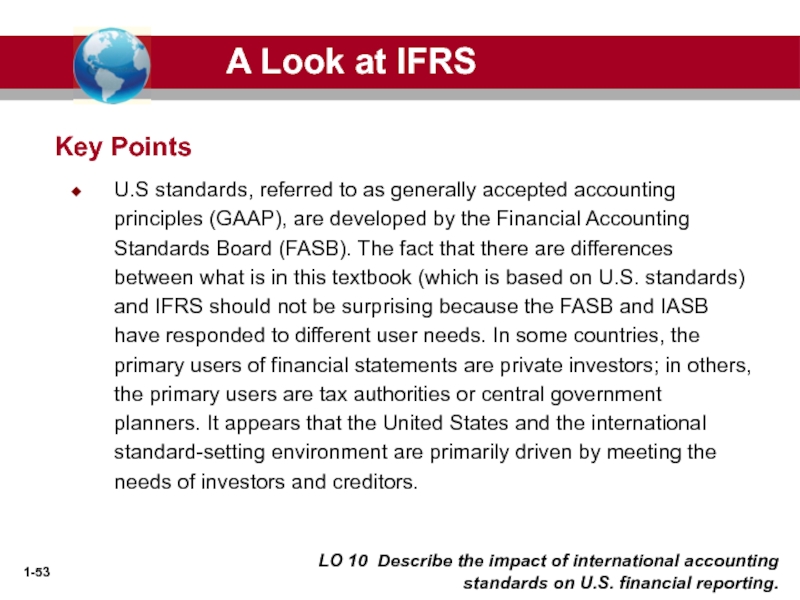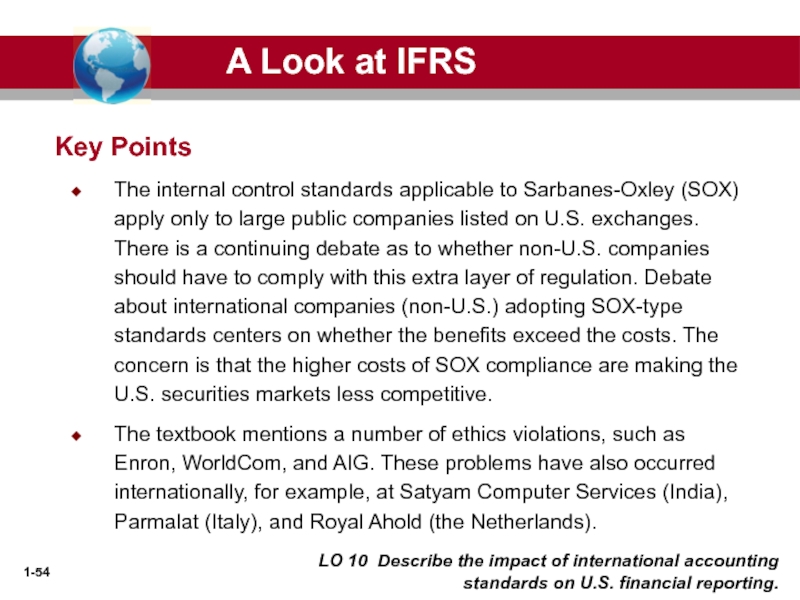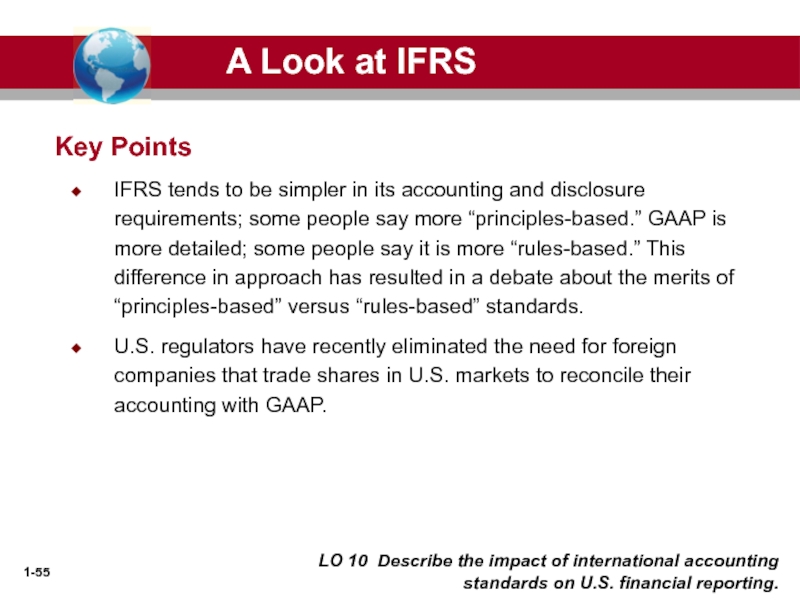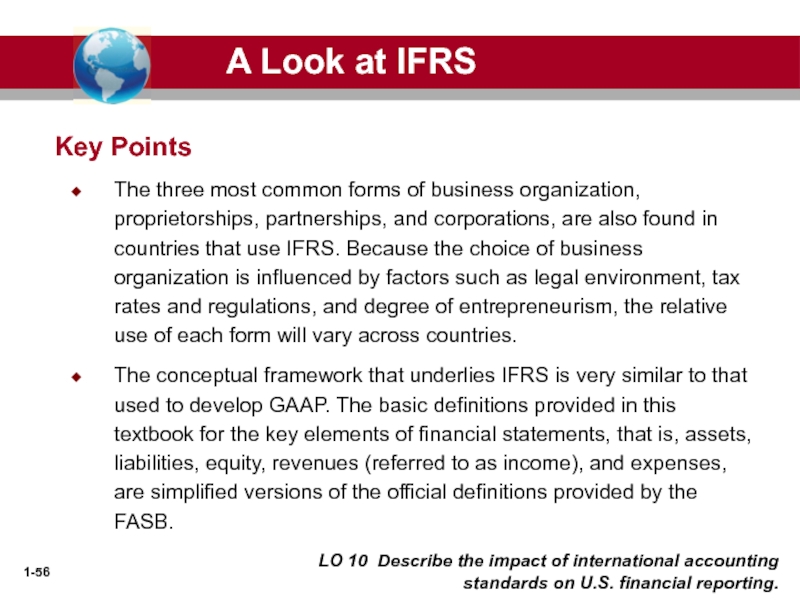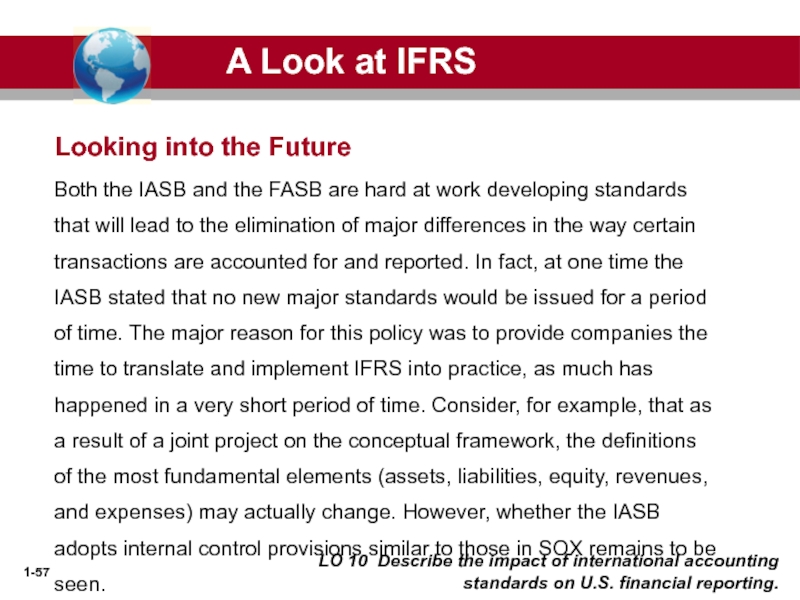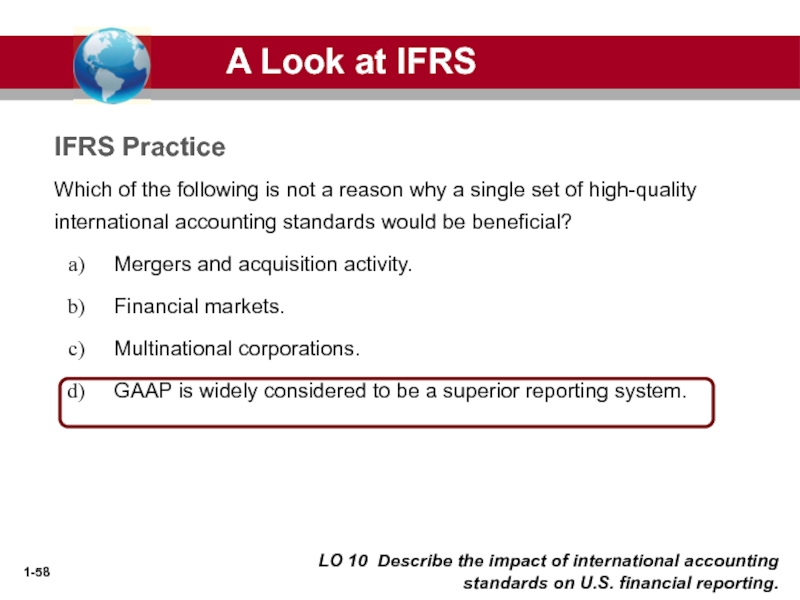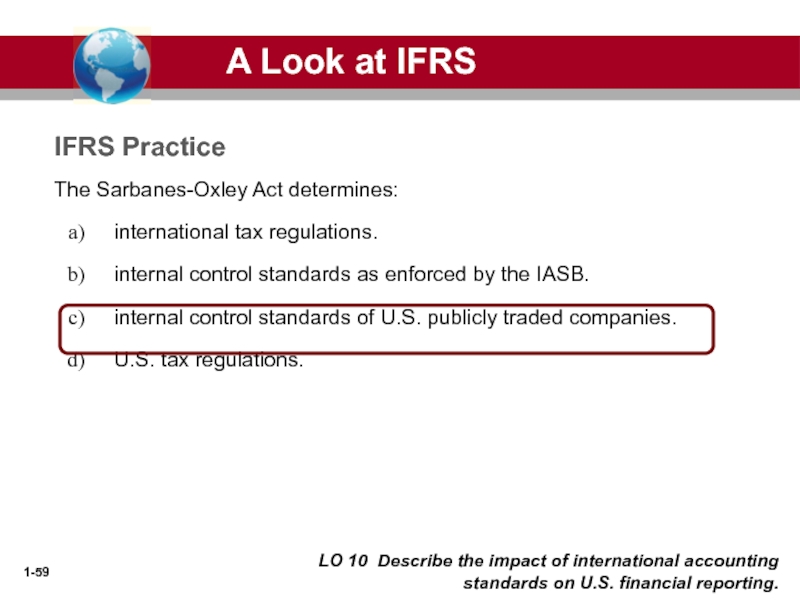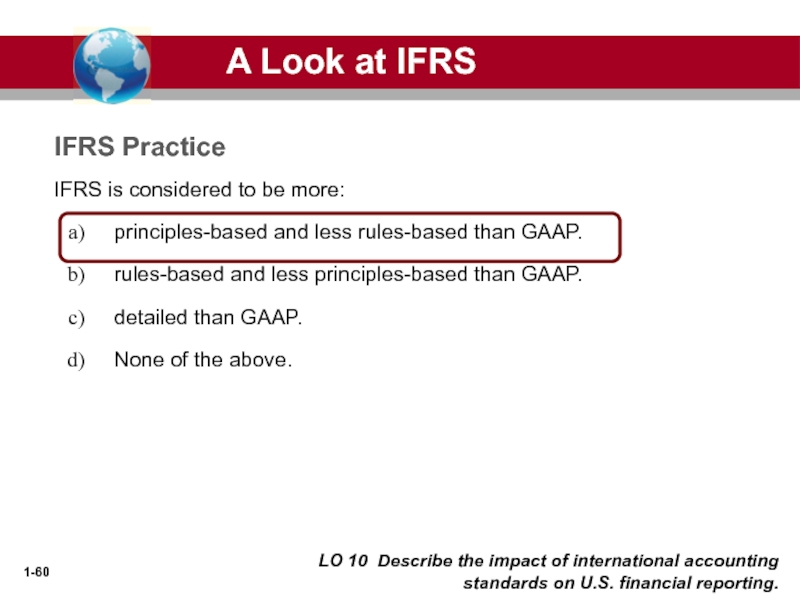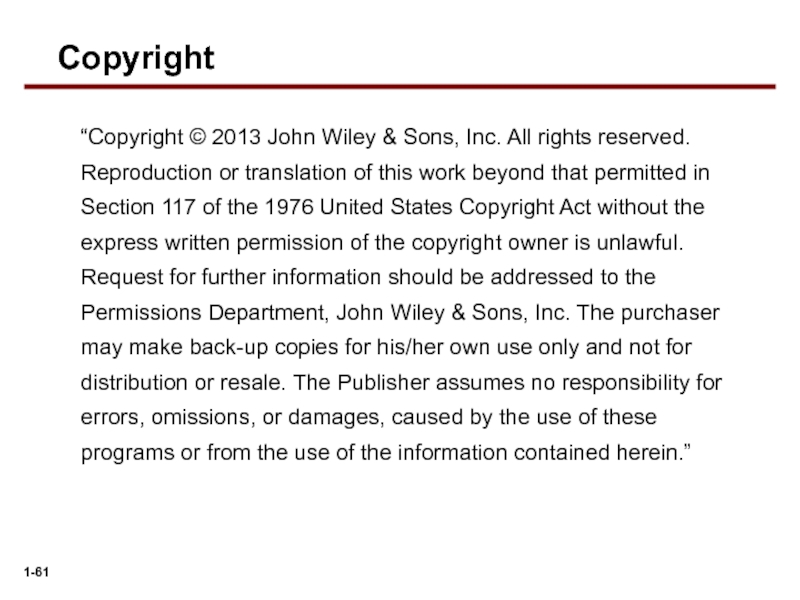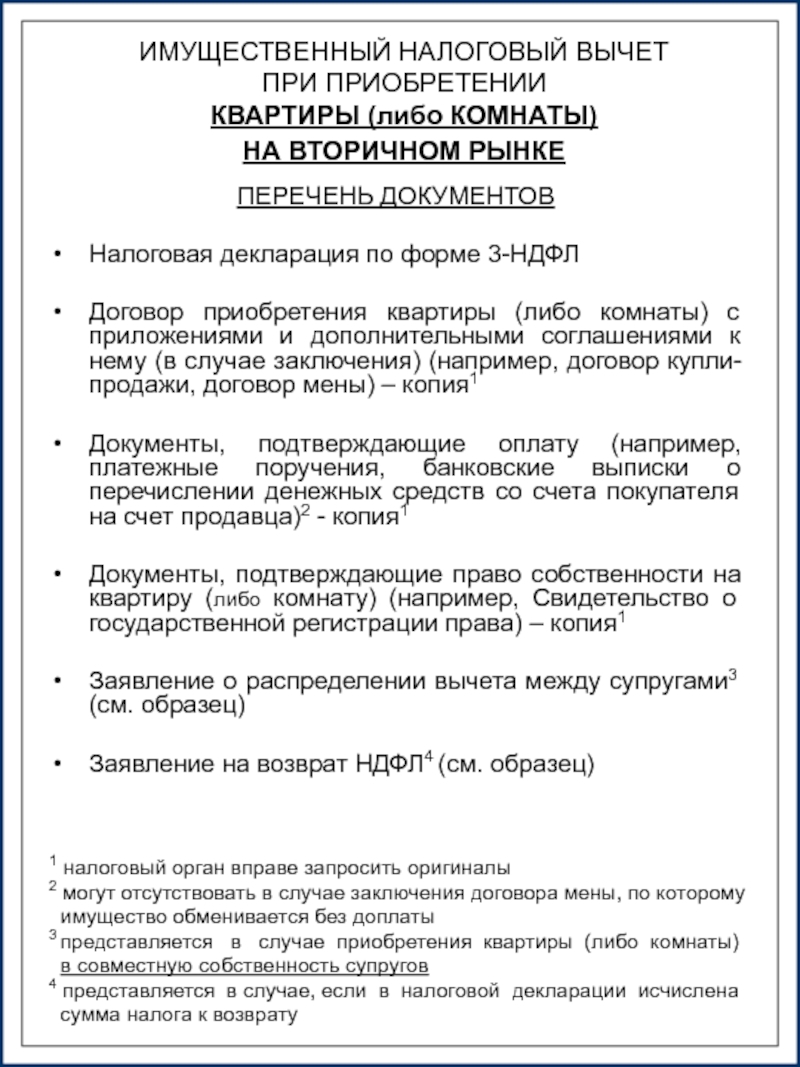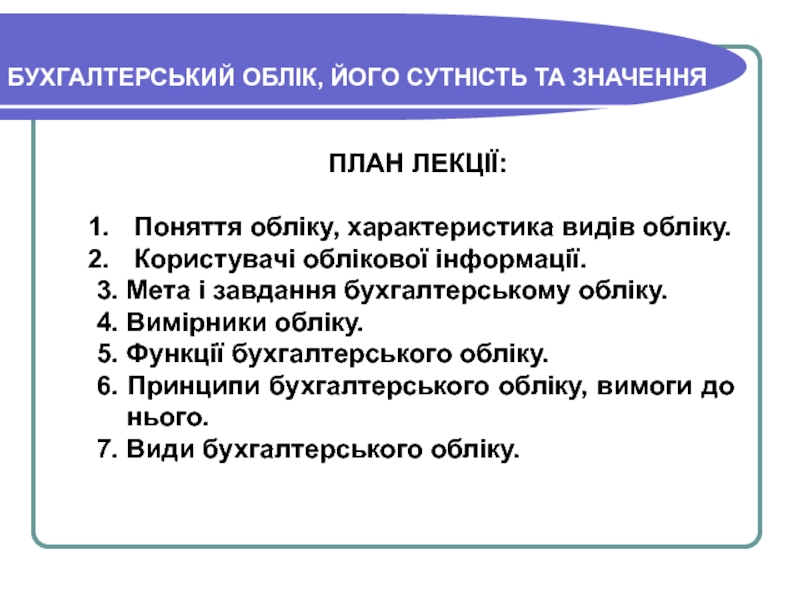- Главная
- Разное
- Дизайн
- Бизнес и предпринимательство
- Аналитика
- Образование
- Развлечения
- Красота и здоровье
- Финансы
- Государство
- Путешествия
- Спорт
- Недвижимость
- Армия
- Графика
- Культурология
- Еда и кулинария
- Лингвистика
- Английский язык
- Астрономия
- Алгебра
- Биология
- География
- Детские презентации
- Информатика
- История
- Литература
- Маркетинг
- Математика
- Медицина
- Менеджмент
- Музыка
- МХК
- Немецкий язык
- ОБЖ
- Обществознание
- Окружающий мир
- Педагогика
- Русский язык
- Технология
- Физика
- Философия
- Химия
- Шаблоны, картинки для презентаций
- Экология
- Экономика
- Юриспруденция
Accounting Principles презентация
Содержание
- 1. Accounting Principles
- 2. 1 Learning Objectives After studying this chapter,
- 3. Preview of Chapter 1 Accounting Principles Eleventh
- 4. LO 1 Explain what accounting is. Purpose
- 5. Three Activities LO 1 Explain what accounting
- 6. LO 2 Internal Users Illustration 1-2
- 8. LO 2 External Users Illustration 1-3
- 9. Ethics In Financial Reporting United States regulators
- 10. Illustration 1-4 Steps in
- 12. Ethics are the standards of conduct by
- 13. Various users need financial information The accounting
- 14. Generally Accepted Accounting Principles (GAAP) - A
- 15. Historical Cost Principle (or cost principle) dictates
- 17. Monetary Unit Assumption requires that companies include
- 18. Proprietorship Partnership Corporation Owned by two or
- 19. Question Combining the activities of Kellogg and
- 20. A business organized as a separate legal
- 22. Provides the underlying framework for recording and
- 23. Assets Liabilities Owner’s Equity = +
- 24. Claims against assets (debts and obligations).
- 25. Ownership claim on total assets. Referred
- 26. Investments by owner are the assets the
- 27. Drawings An owner may withdraw cash or
- 28. Transactions are a business’s economic events recorded
- 29. Illustration: Are the following events recorded in
- 30. Transaction (1): Ray Neal decides to open
- 31. Transaction (2): Purchase of Equipment for Cash.
- 32. Transaction (3): Softbyte purchases for $1,600 from
- 33. Transaction (4): Softbyte receives $1,200 cash from
- 34. Transaction (5): Softbyte receives a bill for
- 35. Transaction (6): Softbyte provides $3,500 of programming
- 36. Transaction (7): Softbyte pays the following expenses
- 37. Transaction (8): Softbyte pays its $250 Daily
- 38. Transaction (9): Softbyte receives $600 in cash
- 39. Transaction (10): Ray Neal withdraws $1,300 in
- 40. Companies prepare four financial statements : Balance
- 41. Net income will result during a time
- 42. Net income is needed to determine the
- 43. The ending balance in owner’s equity is
- 44. The balance sheet and income statement are
- 45. LO 8 Understand the four financial statements
- 46. LO 8 Understand the four financial statements
- 47. LO 8 Understand the four financial statements
- 48. LO 8 Understand the four financial statements
- 50. Which of the following financial statements is
- 51. APPENDIX 1A Accounting Career Opportunities Forensic Accounting
- 52. LO 10 Describe the impact of international
- 53. LO 10 Describe the impact of international
- 54. LO 10 Describe the impact of international
- 55. LO 10 Describe the impact of international
- 56. LO 10 Describe the impact of international
- 57. Both the IASB and the FASB are
- 58. Which of the following is not a
- 59. The Sarbanes-Oxley Act determines: international tax
- 60. IFRS is considered to be more:
- 61. “Copyright © 2013 John Wiley & Sons,
Слайд 21
Learning Objectives
After studying this chapter, you should be able to:
[1] Explain
[2] Identify the users and uses of accounting.
[3] Understand why ethics is a fundamental business concept.
[4] Explain generally accepted accounting principles.
[5] Explain the monetary unit assumption and the economic entity assumption.
[6] State the accounting equation, and define its components.
[7] Analyze the effects of business transactions on the accounting equation.
[8] Understand the four financial statements and how they are prepared.
Accounting in Action
Слайд 4LO 1 Explain what accounting is.
Purpose of accounting is to:
identify,
record,
communicate
the economic events of an organization to interested users.
What is Accounting?
Слайд 5Three Activities
LO 1 Explain what accounting is.
Illustration 1-1
Accounting process
The accounting process
the bookkeeping function.
What is Accounting?
Слайд 6LO 2
Internal Users
Illustration 1-2
Questions that internal users ask
Who Uses
Слайд 9Ethics In Financial Reporting
United States regulators and lawmakers were very concerned
Recent financial scandals include: Enron, WorldCom, HealthSouth, AIG, and others.
Congress passed Sarbanes-Oxley Act of (SOX) 2002.
Effective financial reporting depends on sound ethical behavior.
The Building Blocks of Accounting
LO 3 Understand why ethics is a fundamental business concept.
Слайд 10
Illustration 1-4
Steps in analyzing ethics cases and situations
LO 3 Understand why
The Building Blocks of Accounting
Ethics In Financial Reporting
Слайд 12Ethics are the standards of conduct by which one's actions are
right or wrong.
honest or dishonest.
fair or not fair.
all of these options.
Question
LO 3 Understand why ethics is a fundamental business concept.
Ethics in Financial Reporting
Слайд 13Various users need financial information
The accounting profession has attempted to develop
Financial Statements
Balance Sheet
Income Statement
Statement of Owner’s Equity
Statement of Cash Flows
Note Disclosure
Generally Accepted Accounting Principles (GAAP)
LO 4 Explain generally accepted accounting principles.
Generally Accepted Accounting Principles
Слайд 14Generally Accepted Accounting Principles (GAAP) - A set of rules and
Standard-setting bodies:
Securities and Exchange Commission (SEC)
Financial Accounting Standards Board (FASB)
International Accounting Standards Board (IASB)
Generally Accepted Accounting Principles
LO 4 Explain generally accepted accounting principles.
Слайд 15Historical Cost Principle (or cost principle) dictates that companies record assets
Fair Value Principle states that assets and liabilities should be reported at fair value (the price received to sell an asset or settle a liability).
Generally Accepted Accounting Principles
Measurement Principles
LO 4 Explain generally accepted accounting principles.
Selection of which principle to follow generally relates to trade-offs between relevance and faithful representation.
Слайд 17Monetary Unit Assumption requires that companies include in the accounting records
LO 5 Explain the monetary unit assumption and the economic entity assumption.
Generally Accepted Accounting Principles
Assumptions
Economic Entity Assumption requires that activities of the entity be kept separate and distinct from the activities of its owner and all other economic entities.
Слайд 18Proprietorship
Partnership
Corporation
Owned by two or more persons.
Often retail and service-type businesses
Generally unlimited
Partnership agreement
Ownership divided into shares of stock
Separate legal entity organized under state corporation law
Limited liability
Generally owned by one person.
Often small service-type businesses
Owner receives any profits, suffers any losses, and is personally liable for all debts.
LO 5 Explain the monetary unit assumption and the economic entity assumption.
Forms of Business Ownership
Слайд 19Question
Combining the activities of Kellogg and General Mills would violate the
cost principle.
economic entity assumption.
monetary unit assumption.
ethics principle.
LO 5 Explain the monetary unit assumption and the economic entity assumption.
Generally Accepted Accounting Principles
Слайд 20A business organized as a separate legal entity under state law
proprietorship.
partnership.
corporation.
sole proprietorship.
LO 5 Explain the monetary unit assumption and the economic entity assumption.
Question
Generally Accepted Accounting Principles
Слайд 22Provides the underlying framework for recording and summarizing economic events.
Assets are
Claims of creditors must be paid before ownership claims.
Assets
Liabilities
Owner’s Equity
=
+
LO 6 State the accounting equation, and define its components.
The Basic Accounting Equation
Слайд 23Assets
Liabilities
Owner’s Equity
=
+
Resources a business owns.
Provide future services or benefits.
Cash, Supplies, Equipment,
LO 6 State the accounting equation, and define its components.
Assets
The Basic Accounting Equation
Слайд 24
Claims against assets (debts and obligations).
Creditors - party to whom money
Accounts payable, Notes payable, etc.
LO 6 State the accounting equation, and define its components.
Liabilities
The Basic Accounting Equation
Assets
Liabilities
Owner’s Equity
=
+
Слайд 25
Ownership claim on total assets.
Referred to as residual equity.
Investment by owners
Drawings and expenses (-).
LO 6 State the accounting equation, and define its components.
Owner’s Equity
The Basic Accounting Equation
Assets
Liabilities
Owner’s Equity
=
+
Слайд 26Investments by owner are the assets the owner puts into the
Revenues result from business activities entered into for the purpose of earning income.
Common sources of revenue are: sales, fees, services, commissions, interest, dividends, royalties, and rent.
Illustration 1-6
LO 6 State the accounting equation, and define its components.
Owner’s Equity
Increases in Owner’s Equity
Слайд 27Drawings An owner may withdraw cash or other assets for personal
Expenses are the cost of assets consumed or services used in the process of earning revenue.
Common expenses are: salaries expense, rent expense, utilities expense, tax expense, etc.
Illustration 1-6
LO 6 State the accounting equation, and define its components.
Owner’s Equity
Decreases in Owner’s Equity
Слайд 28Transactions are a business’s economic events recorded by accountants.
May be external
Not all activities represent transactions.
Each transaction has a dual effect on the accounting equation.
LO 7 Analyze the effects of business transactions on the accounting equation.
Using the Accounting Equation
Слайд 29Illustration: Are the following events recorded in the accounting records?
Event
Purchase computer
Criterion
Is
Pay rent
Record/ Don’t Record
LO 7 Analyze the effects of business transactions on the accounting equation.
Using the Accounting Equation
Discuss guided trip options with customer
Слайд 30Transaction (1): Ray Neal decides to open a computer programming service
LO 7
Transaction Analysis
Слайд 31Transaction (2): Purchase of Equipment for Cash. Softbyte purchases computer equipment
LO 7
Transaction Analysis
Слайд 32Transaction (3): Softbyte purchases for $1,600 from Acme Supply Company computer
LO 7
Transaction Analysis
Слайд 33Transaction (4): Softbyte receives $1,200 cash from customers for programming services
LO 7
Transaction Analysis
Слайд 34Transaction (5): Softbyte receives a bill for $250 from the Daily
LO 7
Transaction Analysis
Слайд 35Transaction (6): Softbyte provides $3,500 of programming services for customers. The
LO 7
Transaction Analysis
Слайд 36Transaction (7): Softbyte pays the following expenses in cash for September:
LO 7
Transaction Analysis
Слайд 38Transaction (9): Softbyte receives $600 in cash from customers who had
LO 7
Transaction Analysis
Слайд 39Transaction (10): Ray Neal withdraws $1,300 in cash from the business
LO 7
Transaction Analysis
Illustration 1-8
Tabular summary of
Softbyte transactions
Слайд 40Companies prepare four financial statements :
Balance Sheet
Income Statement
Statement of Cash Flows
Owner’s
LO 8 Understand the four financial statements and how they are prepared.
Financial Statements
Слайд 41Net income will result during a time period when:
assets exceed liabilities.
assets
expenses exceed revenues.
revenues exceed expenses.
LO 8 Understand the four financial statements and how they are prepared.
Financial Statements
Question
Слайд 42Net income is needed to determine the ending balance in owner’s
Illustration 1-9
Financial statements and
their interrelationships
Financial Statements
LO 8
Слайд 43The ending balance in owner’s equity is needed in preparing the
Financial Statements
Illustration 1-9
LO 8
Слайд 44The balance sheet and income statement are needed to prepare statement
Financial Statements
Illustration 1-9
LO 8
Слайд 45LO 8 Understand the four financial statements and how they are
Reports the revenues and expenses for a specific period of time.
Lists revenues first, followed by expenses.
Shows net income (or net loss).
Financial Statements
Income Statement
Слайд 46LO 8 Understand the four financial statements and how they are
Reports the changes in owner’s equity for a specific period of time.
The time period is the same as that covered by the income statement.
Financial Statements
Owner’s Equity Statement
Слайд 47LO 8 Understand the four financial statements and how they are
Reports the assets, liabilities, and owner’s equity at a specific date.
Lists assets at the top, followed by liabilities and owner’s equity.
Total assets must equal total liabilities and owner’s equity.
Is a snapshot of the company’s financial condition at a specific moment in time (usually the month-end or year-end).
Financial Statements
Balance Sheet
Слайд 48LO 8 Understand the four financial statements and how they are
Information for a specific period of time.
Answers the following:
Where did cash come from?
What was cash used for?
What was the change in the cash balance?
Financial Statements
Statement of Cash Flows
Слайд 50Which of the following financial statements is prepared as of a
Balance sheet.
Income statement.
Owner's equity statement.
Statement of cash flows.
LO 8 Understand the four financial statements and how they are prepared.
Financial Statements
Question
Слайд 51APPENDIX 1A Accounting Career Opportunities
Forensic Accounting
Uses accounting, auditing, and investigative skills
Government
Careers with the IRS, the FBI, the SEC, and in public colleges and universities.
Private Accounting
Careers in industry working in cost accounting, budgeting, accounting information systems, and taxation.
LO 9 Explain the career opportunities in accounting.
Public Accounting
Careers in auditing, taxation, and management consulting serving the general public.
Слайд 52LO 10 Describe the impact of international accounting standards on U.S.
Key Points
International standards are referred to as International Financial Reporting Standards (IFRS), developed by the International Accounting Standards Board (IASB).
Recent events in the global capital markets have underscored the importance of financial disclosure and transparency not only in the United States but in markets around the world. As a result, many are examining which accounting and financial disclosure rules should be followed. As indicated in the graphic on the next page, much of the world has voted for the standards issued by the IASB. Over 115 countries require or permit use of IFRS.
A Look at IFRS
Слайд 53LO 10 Describe the impact of international accounting standards on U.S.
Key Points
U.S standards, referred to as generally accepted accounting principles (GAAP), are developed by the Financial Accounting Standards Board (FASB). The fact that there are differences between what is in this textbook (which is based on U.S. standards) and IFRS should not be surprising because the FASB and IASB have responded to different user needs. In some countries, the primary users of financial statements are private investors; in others, the primary users are tax authorities or central government planners. It appears that the United States and the international standard-setting environment are primarily driven by meeting the needs of investors and creditors.
A Look at IFRS
Слайд 54LO 10 Describe the impact of international accounting standards on U.S.
Key Points
The internal control standards applicable to Sarbanes-Oxley (SOX) apply only to large public companies listed on U.S. exchanges. There is a continuing debate as to whether non-U.S. companies should have to comply with this extra layer of regulation. Debate about international companies (non-U.S.) adopting SOX-type standards centers on whether the benefits exceed the costs. The concern is that the higher costs of SOX compliance are making the U.S. securities markets less competitive.
The textbook mentions a number of ethics violations, such as Enron, WorldCom, and AIG. These problems have also occurred internationally, for example, at Satyam Computer Services (India), Parmalat (Italy), and Royal Ahold (the Netherlands).
A Look at IFRS
Слайд 55LO 10 Describe the impact of international accounting standards on U.S.
Key Points
IFRS tends to be simpler in its accounting and disclosure requirements; some people say more “principles-based.” GAAP is more detailed; some people say it is more “rules-based.” This difference in approach has resulted in a debate about the merits of “principles-based” versus “rules-based” standards.
U.S. regulators have recently eliminated the need for foreign companies that trade shares in U.S. markets to reconcile their accounting with GAAP.
A Look at IFRS
Слайд 56LO 10 Describe the impact of international accounting standards on U.S.
Key Points
The three most common forms of business organization, proprietorships, partnerships, and corporations, are also found in countries that use IFRS. Because the choice of business organization is influenced by factors such as legal environment, tax rates and regulations, and degree of entrepreneurism, the relative use of each form will vary across countries.
The conceptual framework that underlies IFRS is very similar to that used to develop GAAP. The basic definitions provided in this textbook for the key elements of financial statements, that is, assets, liabilities, equity, revenues (referred to as income), and expenses, are simplified versions of the official definitions provided by the FASB.
A Look at IFRS
Слайд 57Both the IASB and the FASB are hard at work developing
Looking into the Future
A Look at IFRS
LO 10 Describe the impact of international accounting standards on U.S. financial reporting.
Слайд 58Which of the following is not a reason why a single
Mergers and acquisition activity.
Financial markets.
Multinational corporations.
GAAP is widely considered to be a superior reporting system.
A Look at IFRS
IFRS Practice
LO 10 Describe the impact of international accounting standards on U.S. financial reporting.
Слайд 59
The Sarbanes-Oxley Act determines:
international tax regulations.
internal control standards as enforced by
internal control standards of U.S. publicly traded companies.
U.S. tax regulations.
A Look at IFRS
IFRS Practice
LO 10 Describe the impact of international accounting standards on U.S. financial reporting.
Слайд 60
IFRS is considered to be more:
principles-based and less rules-based than GAAP.
rules-based
detailed than GAAP.
None of the above.
IFRS Practice
A Look at IFRS
LO 10 Describe the impact of international accounting standards on U.S. financial reporting.
Слайд 61“Copyright © 2013 John Wiley & Sons, Inc. All rights reserved.
Copyright
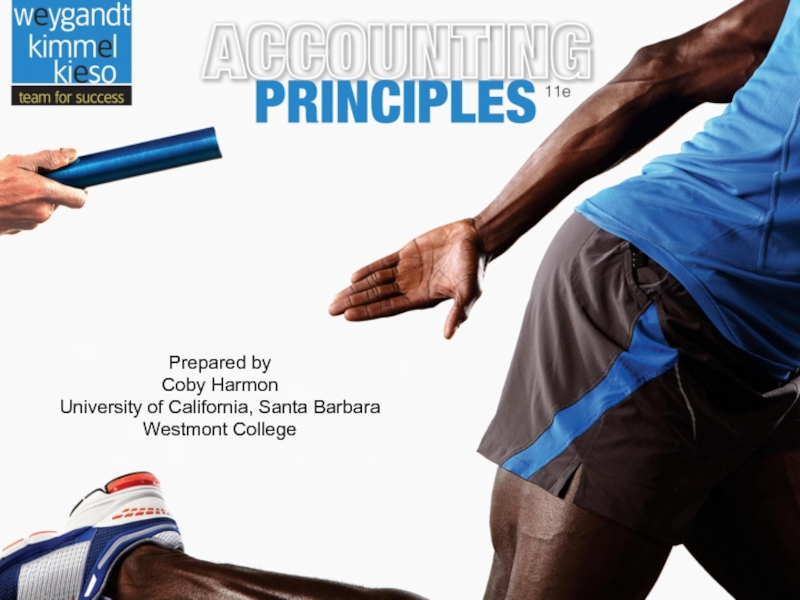
![1Learning ObjectivesAfter studying this chapter, you should be able to:[1] Explain what accounting is.[2] Identify](/img/tmb/4/332601/79fbd44e74cabbf28ef8d87211833fa0-800x.jpg)
